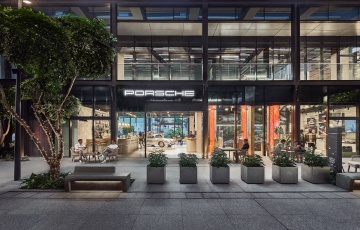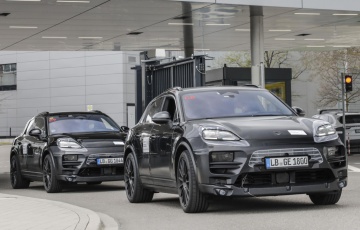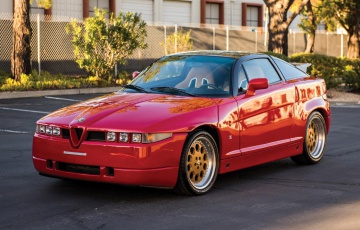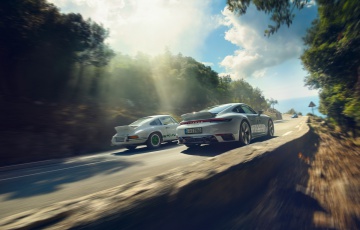Prisoners of the Sun : Porsche 991 Carrera 4S Cabriolet x 930 Cabriolet x 911 Carrera Cabriolet
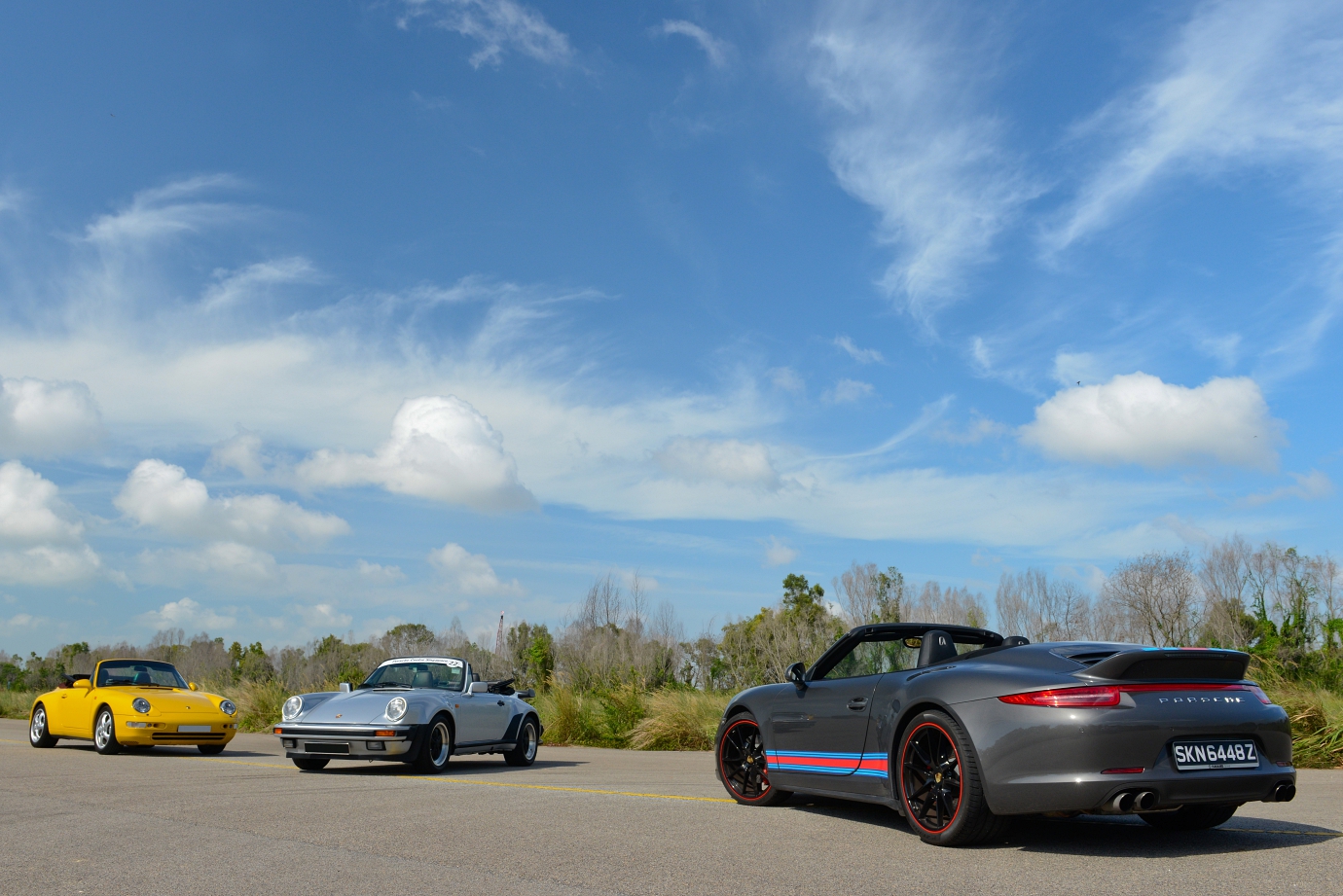
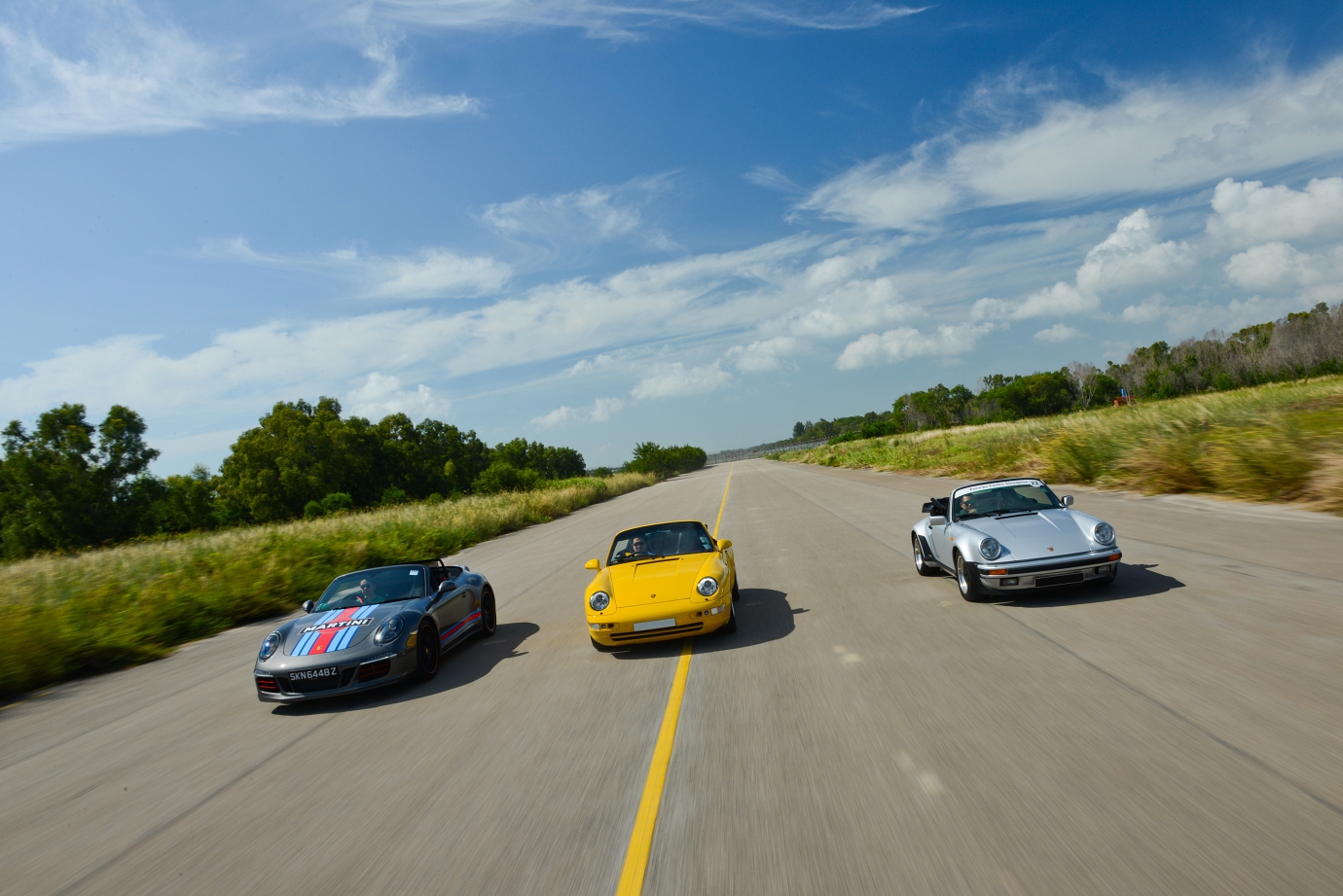
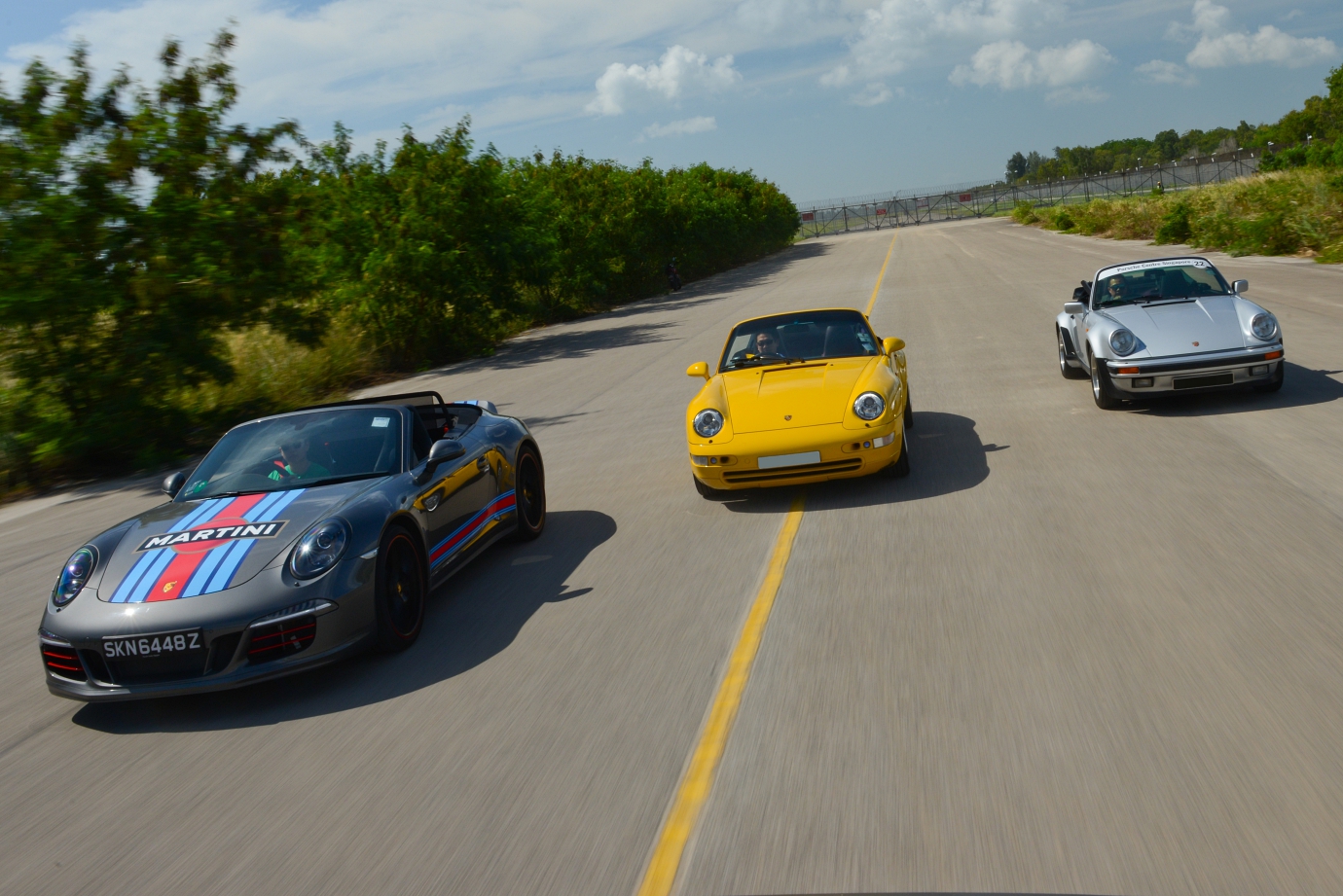
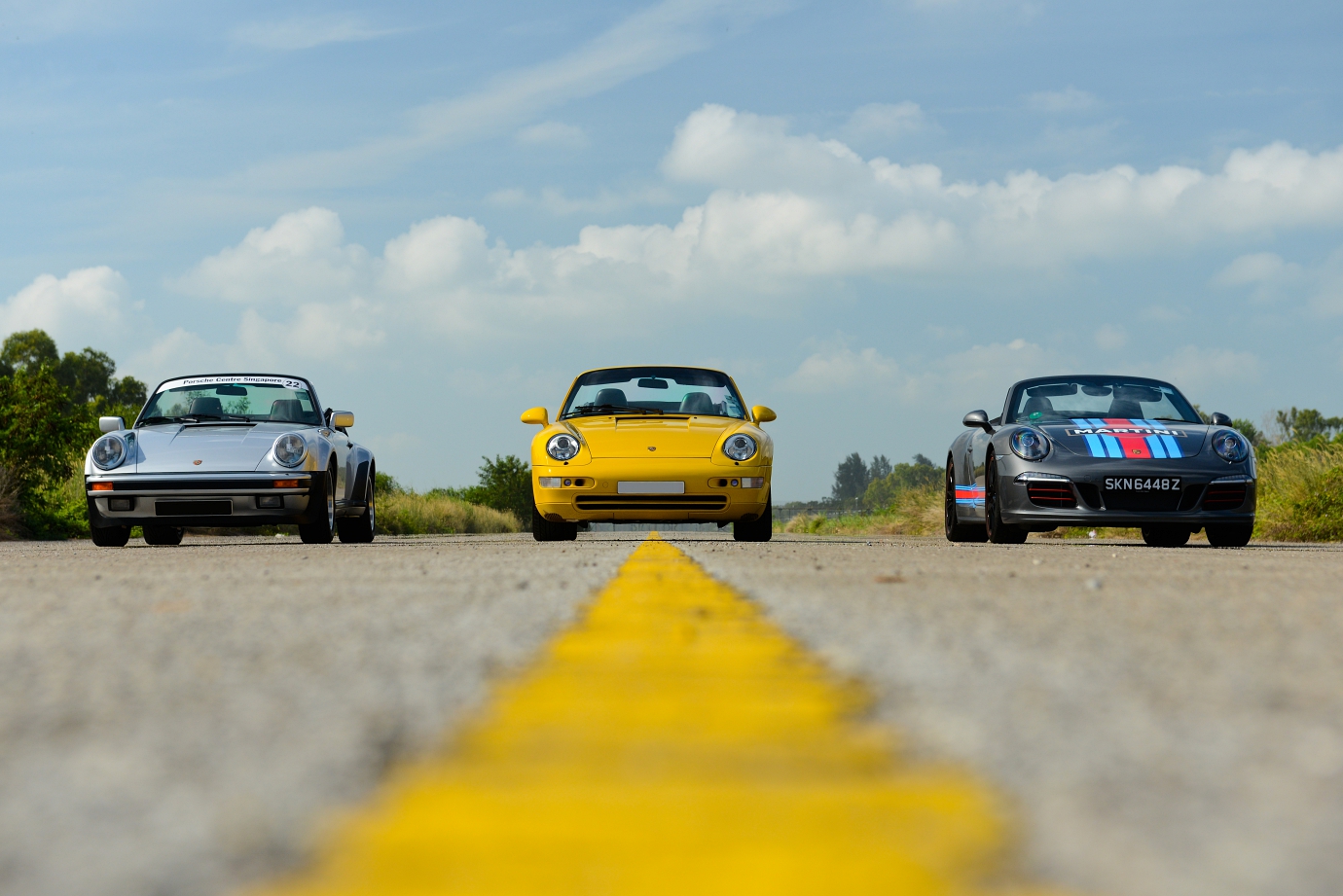
Singapore – While our intrepid colleagues were busy chasing snow-flurries all-around the globe ‘Frozen’-style, we decided to make the most of being stuck in sunny Singapore by organising a cabriolet party. And not just any cabriolet, mind you, but 911s-only.
For the most part, locals are a practical bunch who don’t see the point in searing themselves under the sun, be it morning, midday or afternoon, much less tool around with the rag-tops down in what the Euro/ Yanks would term ‘convertible weather’.
Odds are eight out of ten cabriolets you see will have their roofs up (unless it’s late at night, but even then maybe not!), with the other two typically driven by folks who don’t get a lot of sun where they come from.
Despite the classical soft silhouette of soft-tops with the tops on, we decide to punish ourselves on a saturday morning by leaving the tops of the three cars down for the duration of the shoot.
Thankfully, Singapore has been experiencing pretty cool low to mid-20s ºC up til about lunch time, so even with the sun out, the heat isn’t intolerable.
Moreover, seeing as how rare an occurrence it is for the tops to go down, we felt it would be refreshing change from all the usual top-up shots.
We’re huge fans of soft-tops (as opposed to hard-top convertibles), not least because of their gentler silhouettes, but also because we prefer not to have a single car fulfill multiple duties – after all, these aren’t Swiss Army Knives.
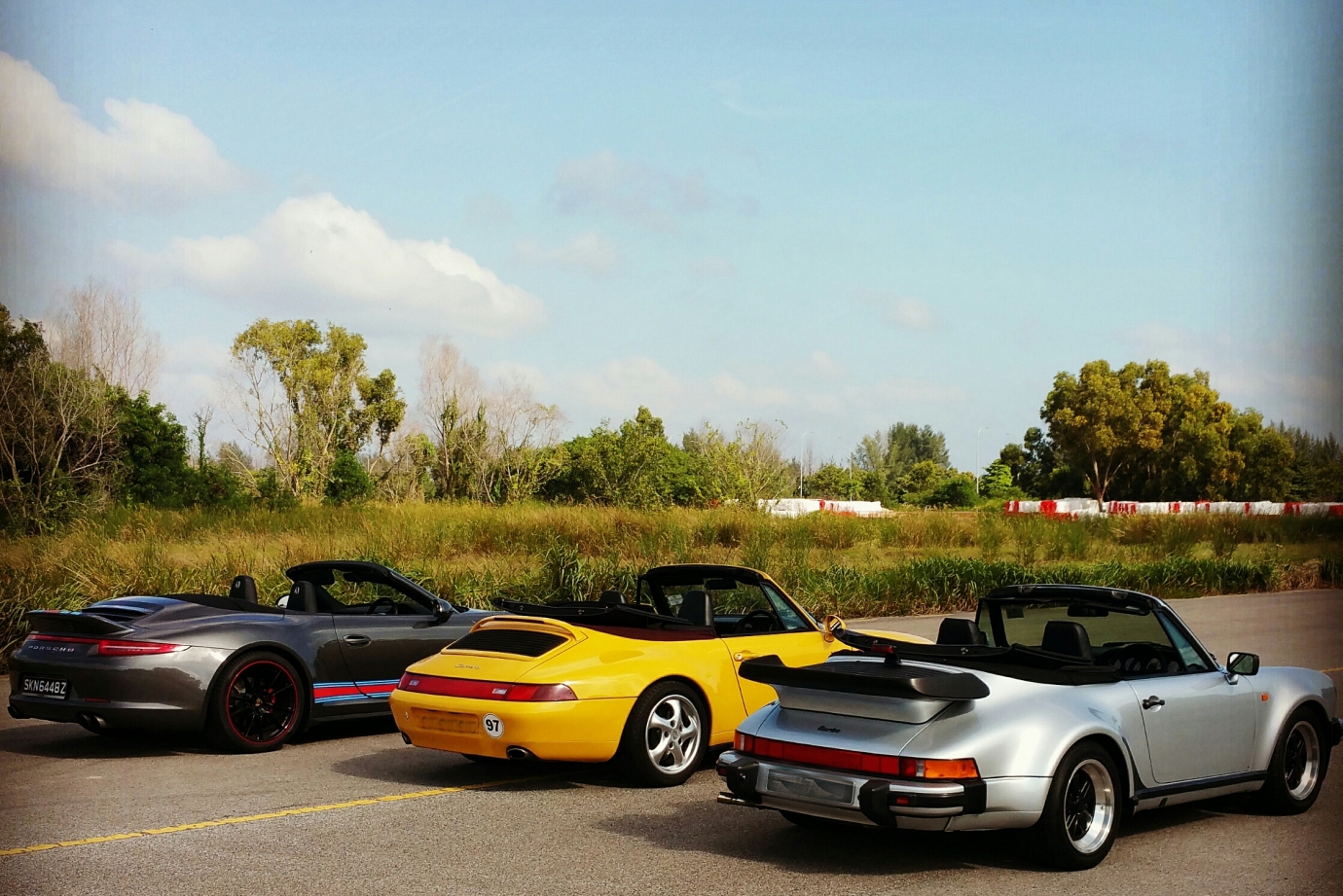
Like sportscars, a convertible should be an indulgence and an evocative enough proposition for when the company is good, the weather is pleasant and the streets are empty.
It’s easy to dismiss convertibles as poseurs that are less drive-focused (we contend they are as, if not more driver-focused!) than their fixed-roof counterparts, but our day in the sun with the trio demonstrates otherwise.
Well, that’s not to say the Cabrios perform a lot better than the Coupes, but the reality is, in the real world, you don’t lose out on a lot with these ragtops and more importantly, enjoy the full-blown sensory experience when pressing hard: the sights, sounds and emotion of driving top-down trump the pure go-faster credentials of most fixed-roof performance cars.
At time of writing (in 2015!), the 991.1 C4S Cabrio starts at S$605k excluding COE and options – a rough estimate on the Porsche Configurator pegs the on-the-road price of this particular demo-car at around S$750k...
Its compadres? Well, we’d have had three air-cooled generations of the 911 Cabriolet for you to salivate over, but the 964 was sold a few days before this shoot!
Long-time Porsche enthusiasts will appreciate the emotive appeal of air-cooled 911s – the folks who don’t get it like to ask how fast, how much power, how-this-how-that...
It’s never about the outright speed alone, especially since today’s sportscars have perfected the formula of synthesised speed, even as their souls have been eradicated in the process.
Instead, it’s intriguing how the foibles and flaws of the older cars translate into rather endearing personality traits that make them so real.
Our sun-kissed trio includes the latest 991.1 Carrera 4 S Cabriolet, a type 930 Cabriolet (the first-ever turbo 911 Cabriolet), and an air-cooled 911 Carrera 2 Cabrio.
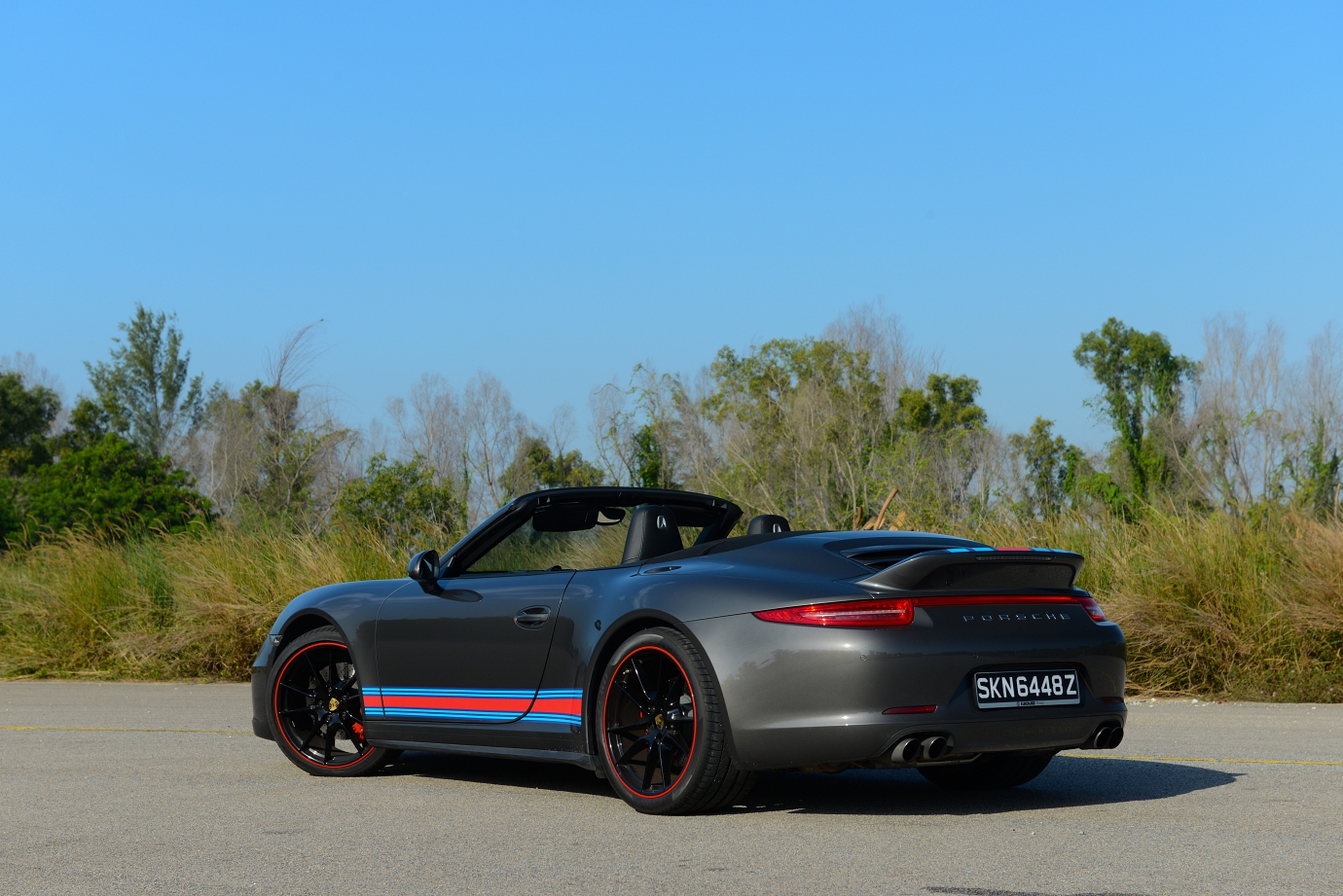
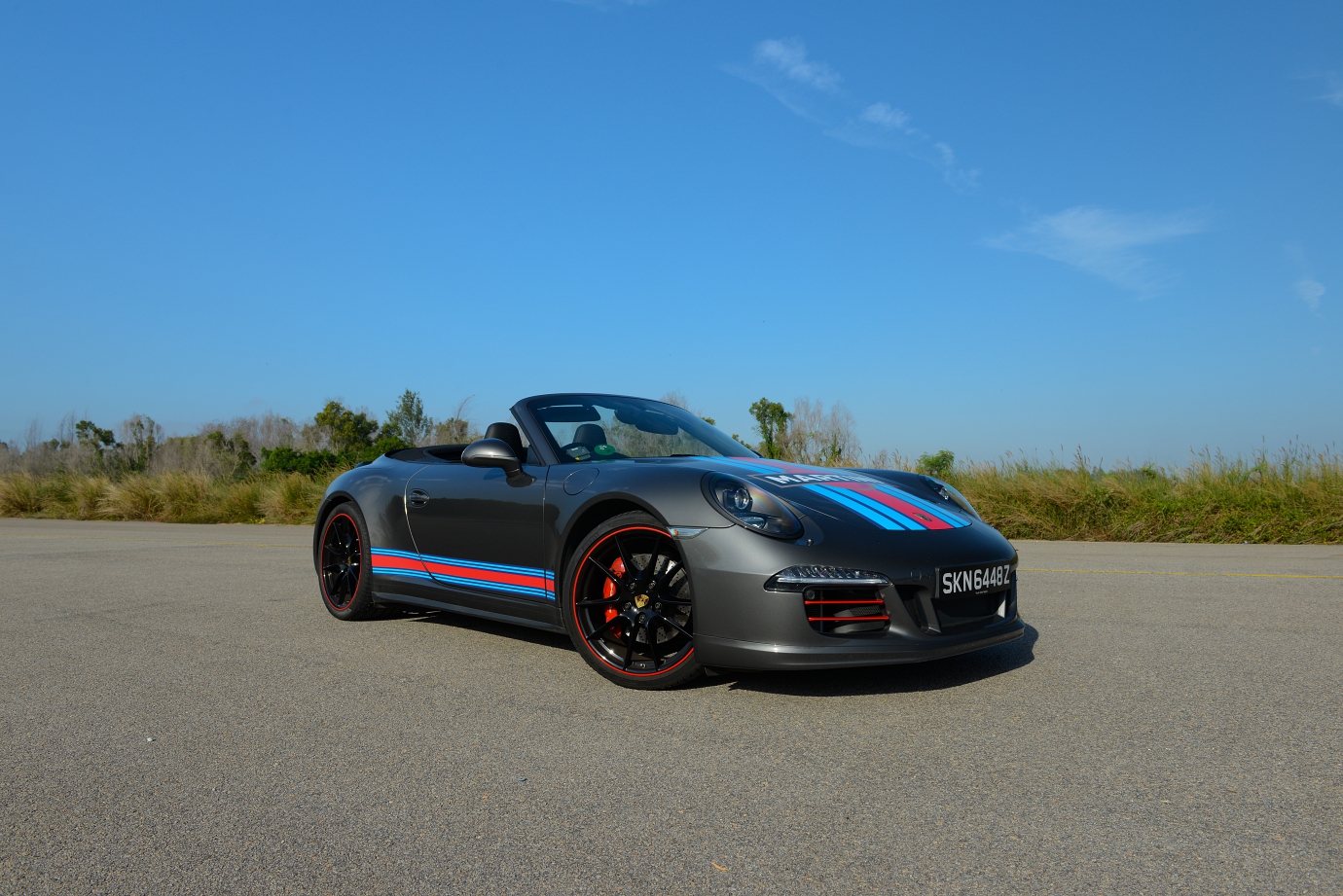
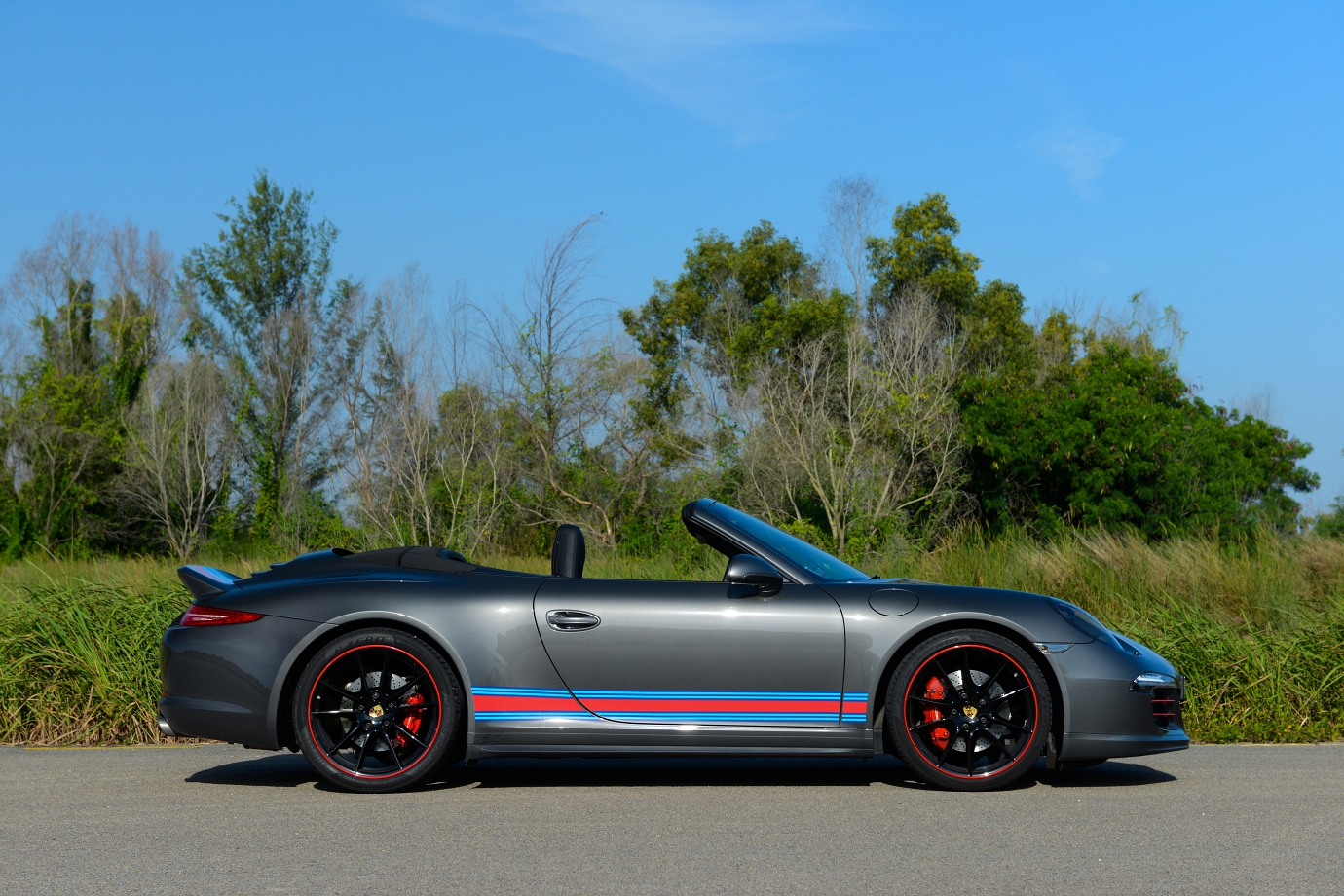
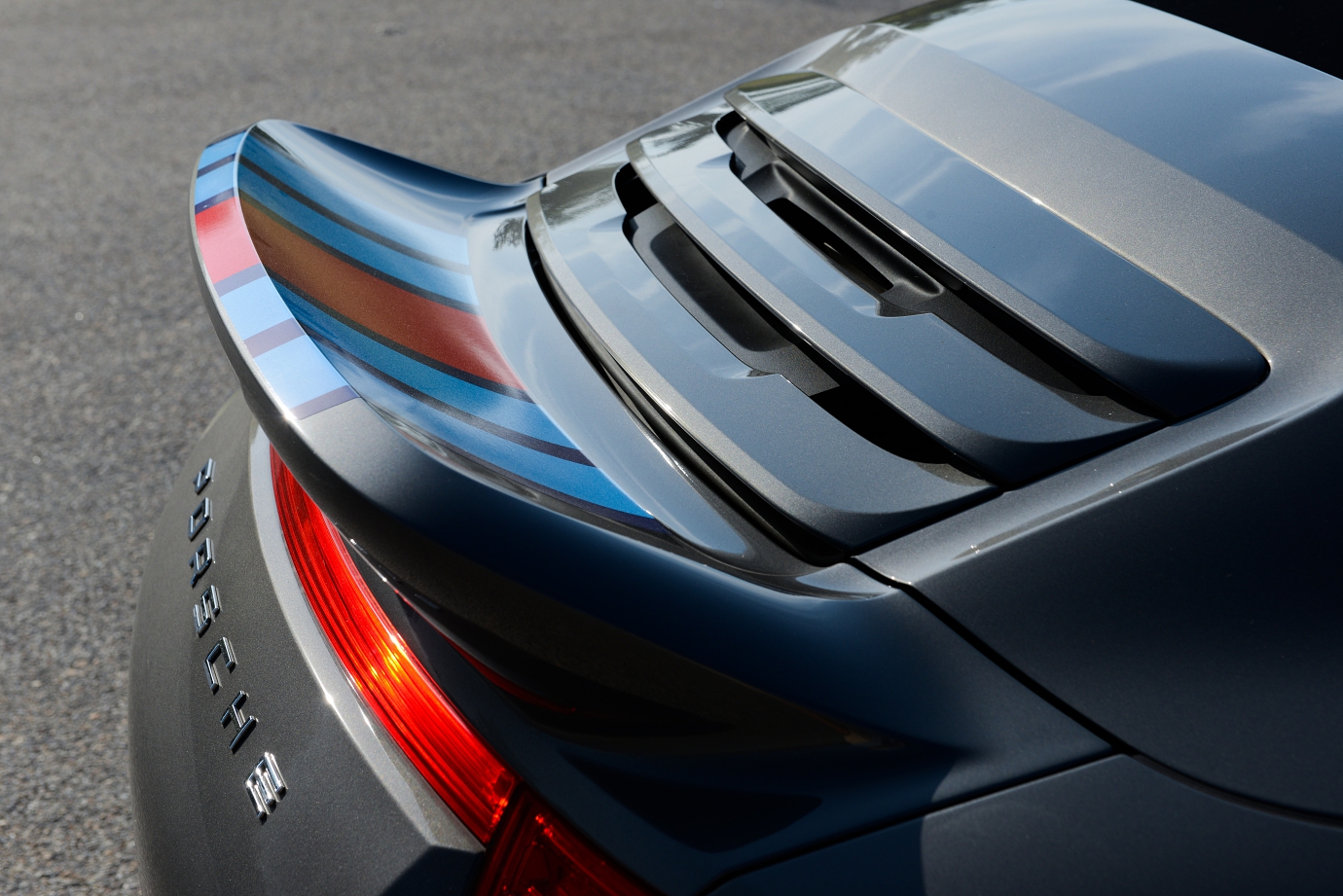
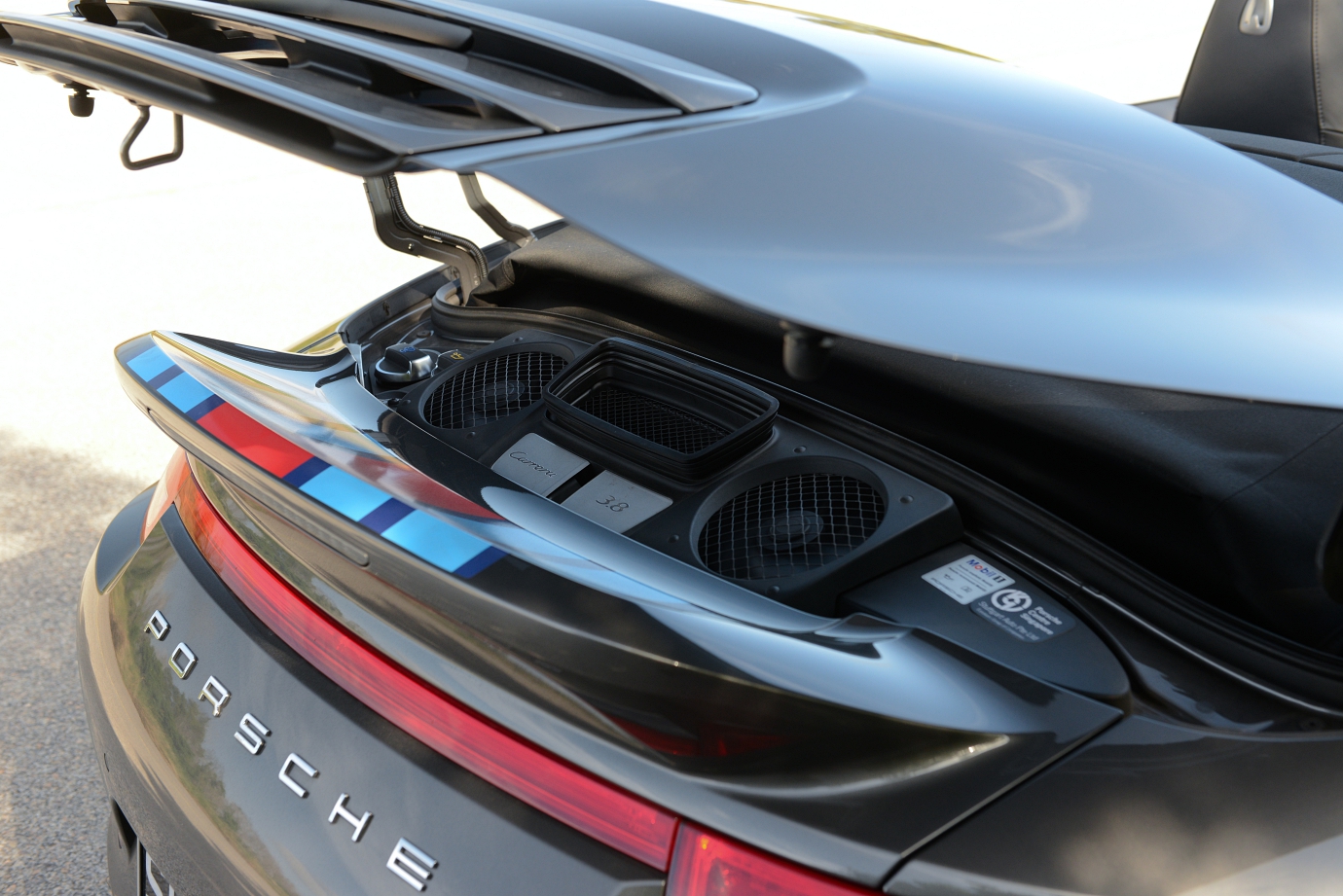
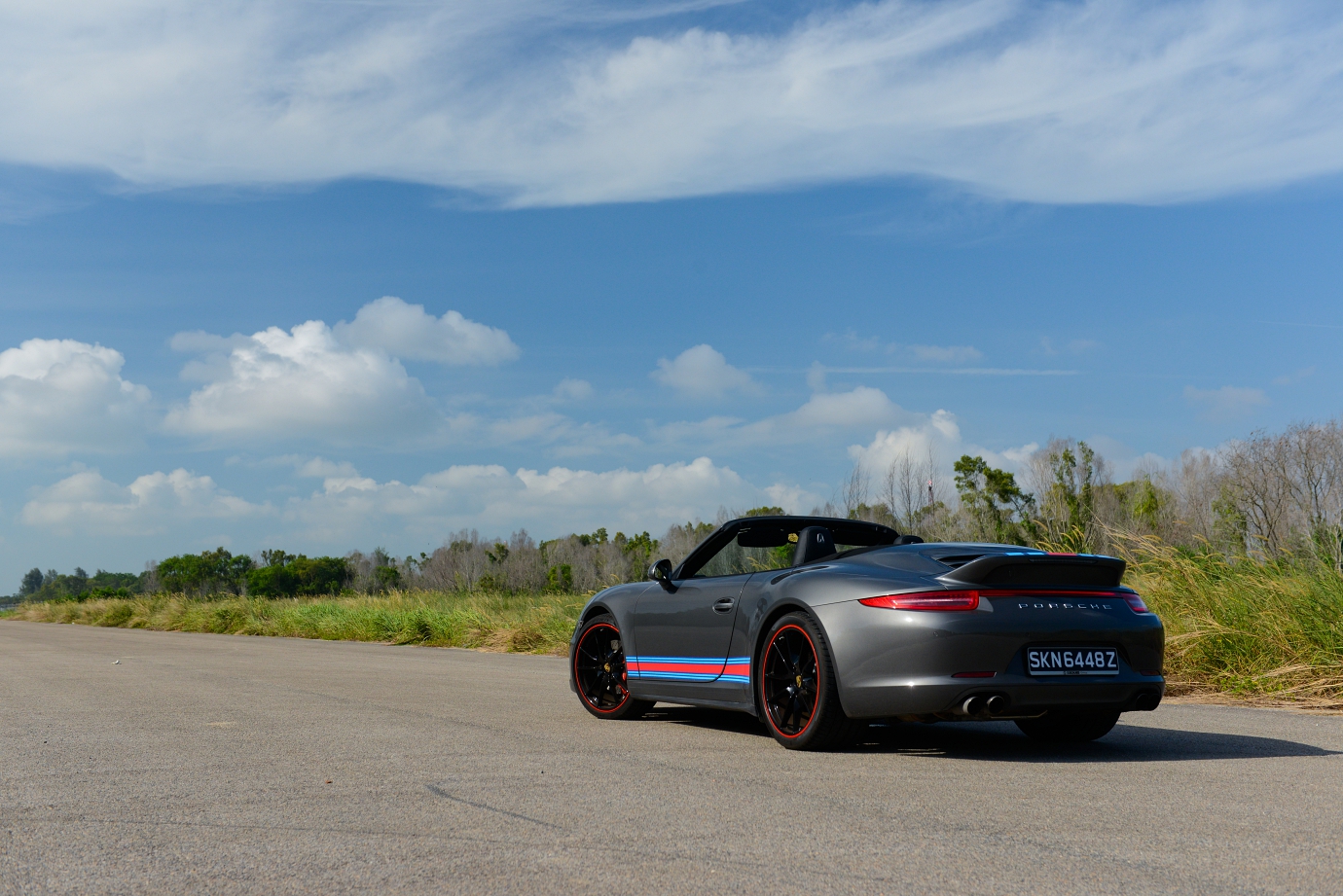
Shaken & Stirred
The 911 (type 991) Carrera 4S Cabriolet that we’ve commandeered for the weekend belongs to Porsche asia Pacific’s head honcho.
It’s a rolling advertisement of sorts to demonstrate the choice bits that can be added to Porsches, including the lurid Martini Racing livery that draws its fair share of attention.
The riot of colours is echoed in even the small details, like the red pin-stripe that runs around the outer rim of the ominous black wheels, as well as the red seatbelts and the touches of carbonfibre and contrast-stitched extended leather in the cabin.
Although the ducktail spoiler is traditionally found on Coupes – most recently, it was standard equipment on the 250-unit special edition 911 (type 997) Sport Classic – it’s been specified in this C4S Cabrio to arguably eye-catching effect, especially with the roof down and prominent, wider-bodied rump of this four-wheel drive model (C4 and C4S models are 44mm wider than their C2 and C2S counterparts).
For those who may be wondering, this retro bit of aero-styling originated from the 2.7 RS from 1973, although today’s far larger iterations of the 911 mean the spoiler is no longer the dainty flap of yesteryear.
(Click HERE to read about the different generations of the stick-shift 911 Carrera)
It’s not just the aesthetic bits that have been specc’d up through the roof (no pun intended), because there’s some substance to all this style.
The C4S Cabrio features the brand’s sport Chrono Package, which makes for all sorts of aural and dynamic magic when engaged, especially since the car boasts PASM (Porsche’s adaptive suspension) and Sports Exhaust – the latter provides a suitably rousing soundtrack when the roof is down.
The roof takes 13secs to operate and it will work at speeds of up to 50km/h, which means it’s possible to bring-on the shelter when the heavens decide to open up on you.
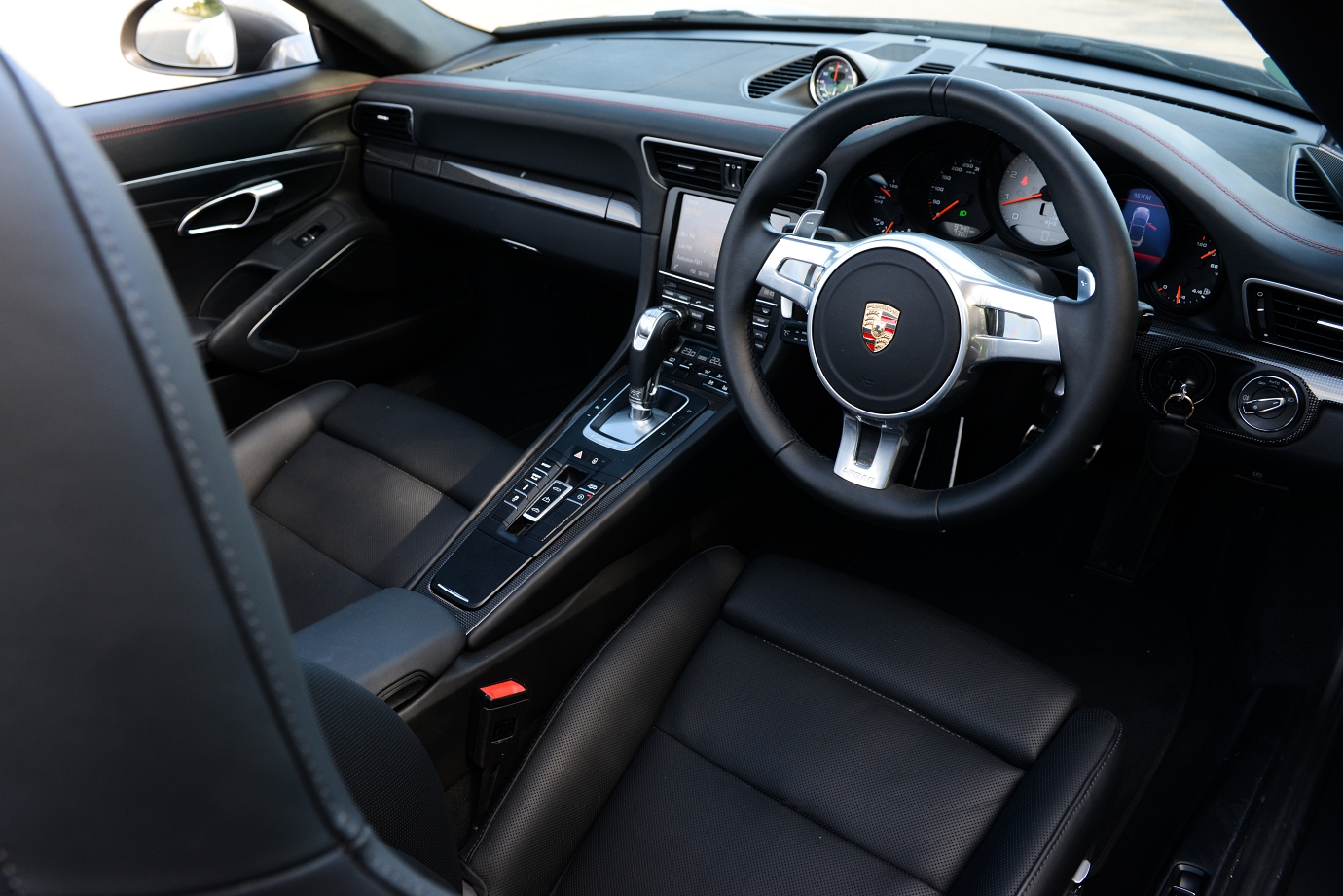
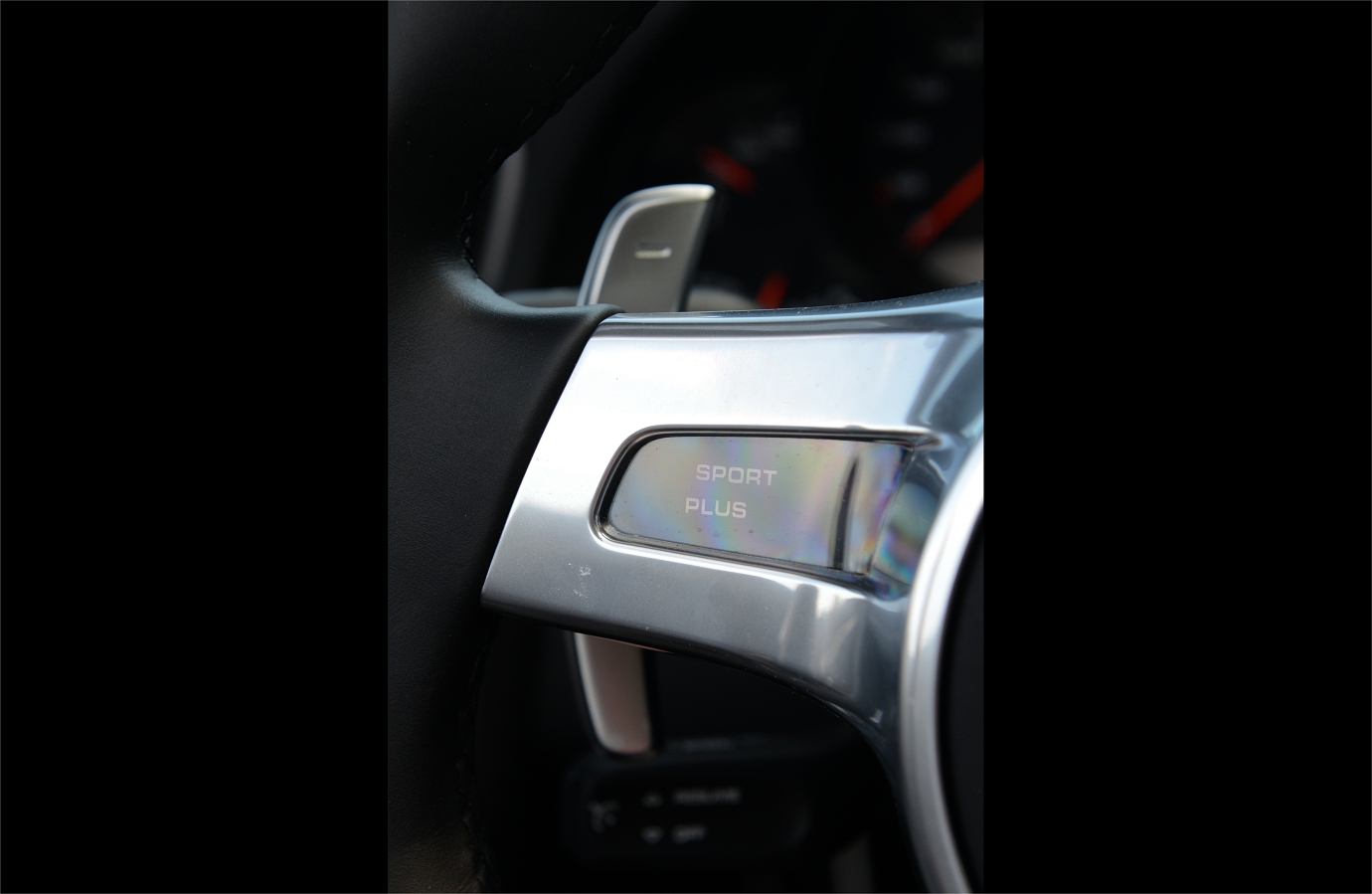
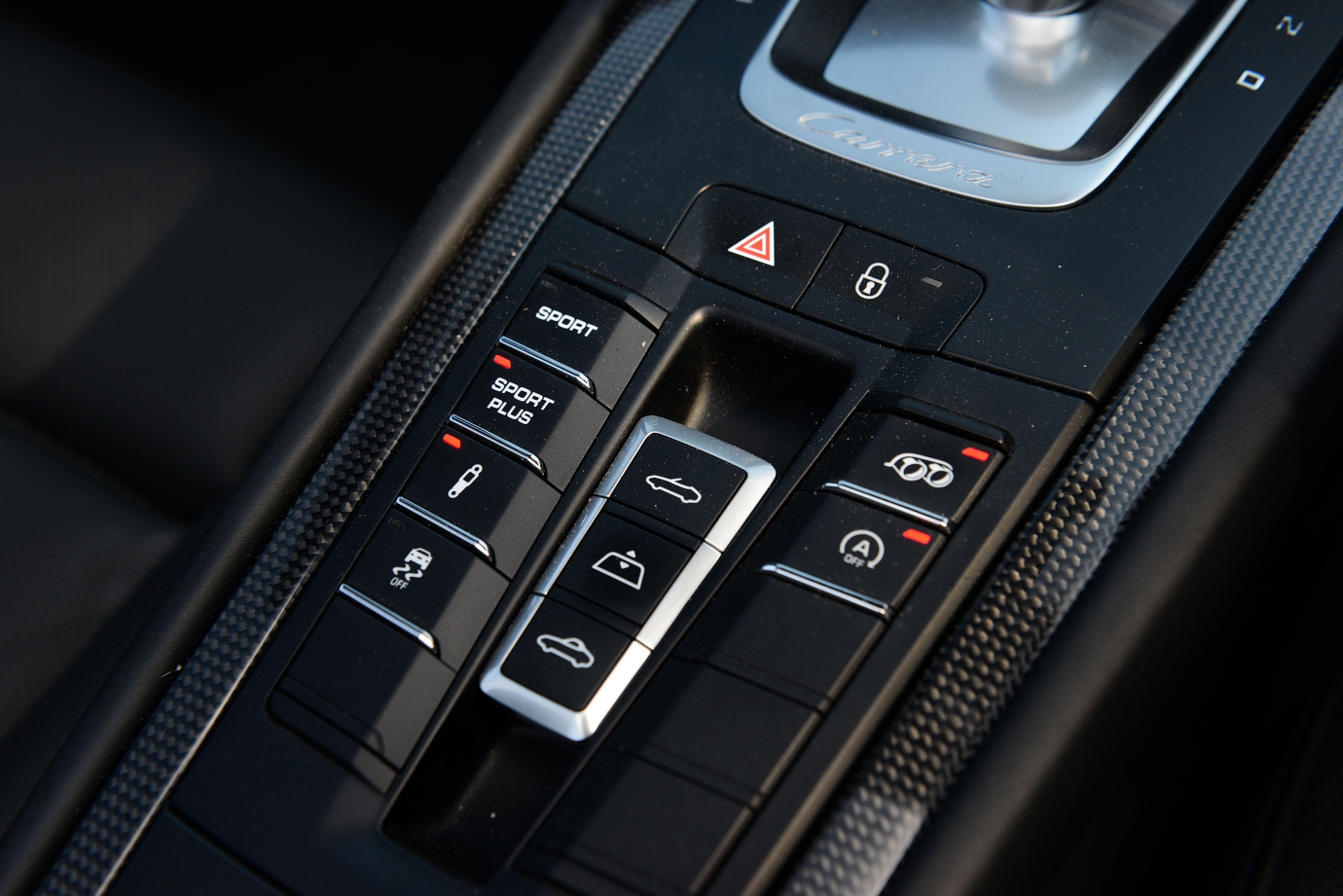
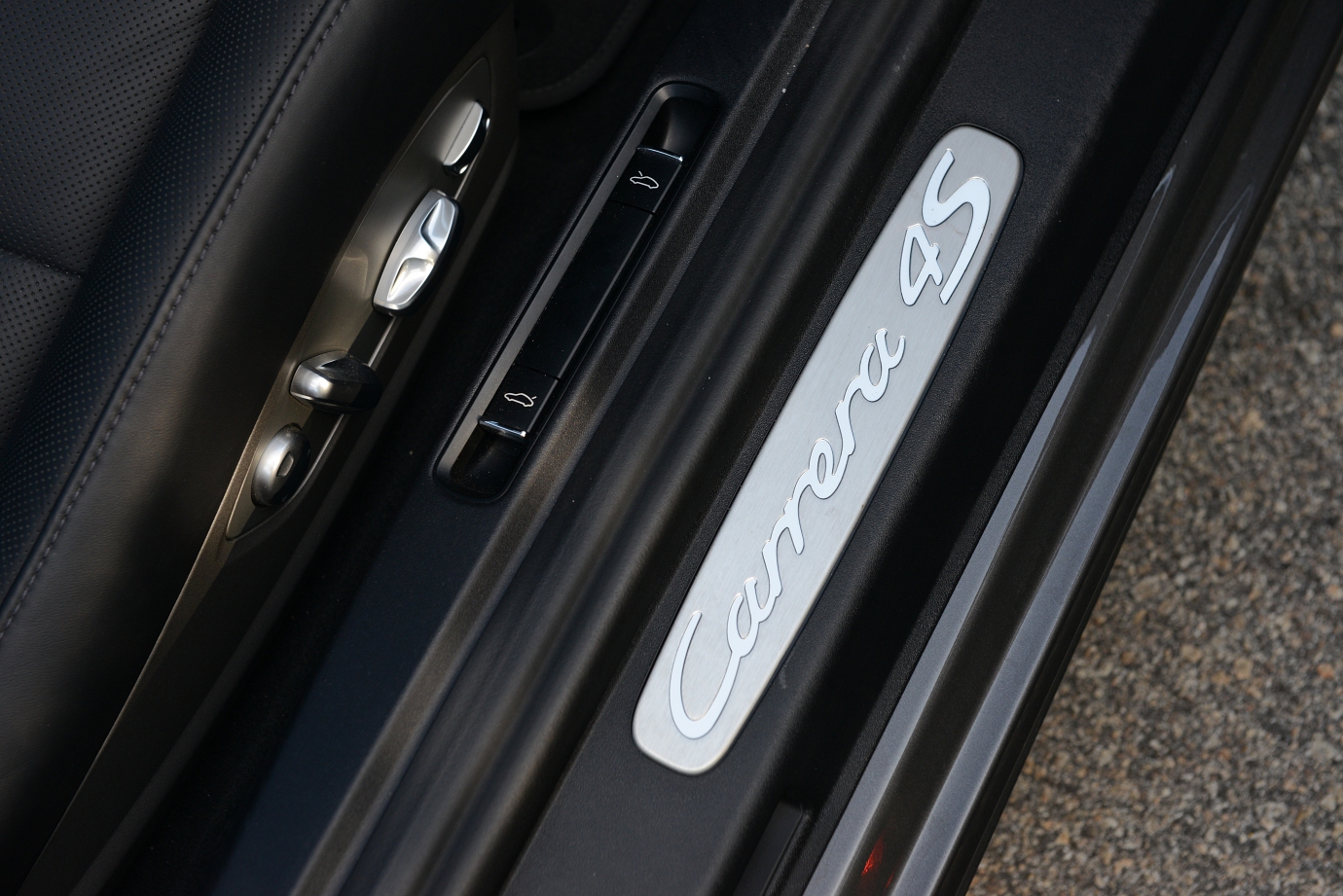
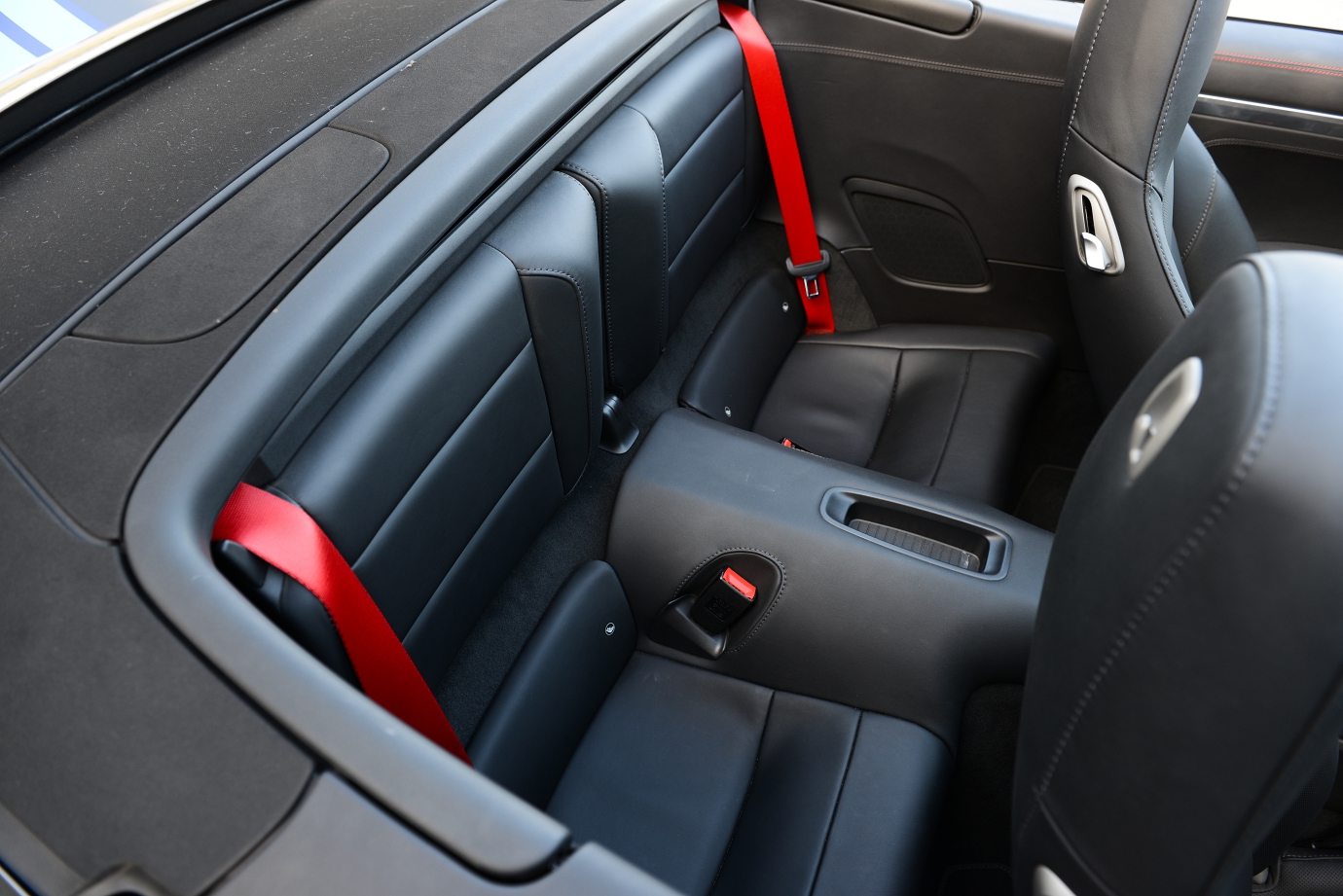
True to serious sportscar form, you still twist a physical key to start-up the car. As you trundle about, it’s possible to mistake it for a far smaller car than its proportions may otherwise suggest, which is a good thing in case you were wondering.
The electro-mechanical steering offers natural, well-weighted responses, which leads us to wonder how so many other brands continue to get it so wrong.
Full Sport Plus mode may prove challenging for most, especially if your drive takes you over manholes and bad roads, since the ride is firmed-up for that sort of body-control you’d appreciate on a crystal smooth race circuit.
Also, the PDK practically erupts from gear to gear to the redline as you go full throttle in this mode. However, all is not lost if all you want is to enjoy the shouty sports exhaust, thanks to a dedicated button on the rising centre console.
There’s a deftness at the helm that makes the C4S a cinch to boot around. The sports steering wheel comes with proper paddle shifters to work the PDK, which is a more intuitive alternative to the push-pull shift system found in some base variants.
There’s enough punch from the 3.8-litre flat-six to make brisk progress on the streets and the standard brakes offer easy and natural modulation for this level of performance.
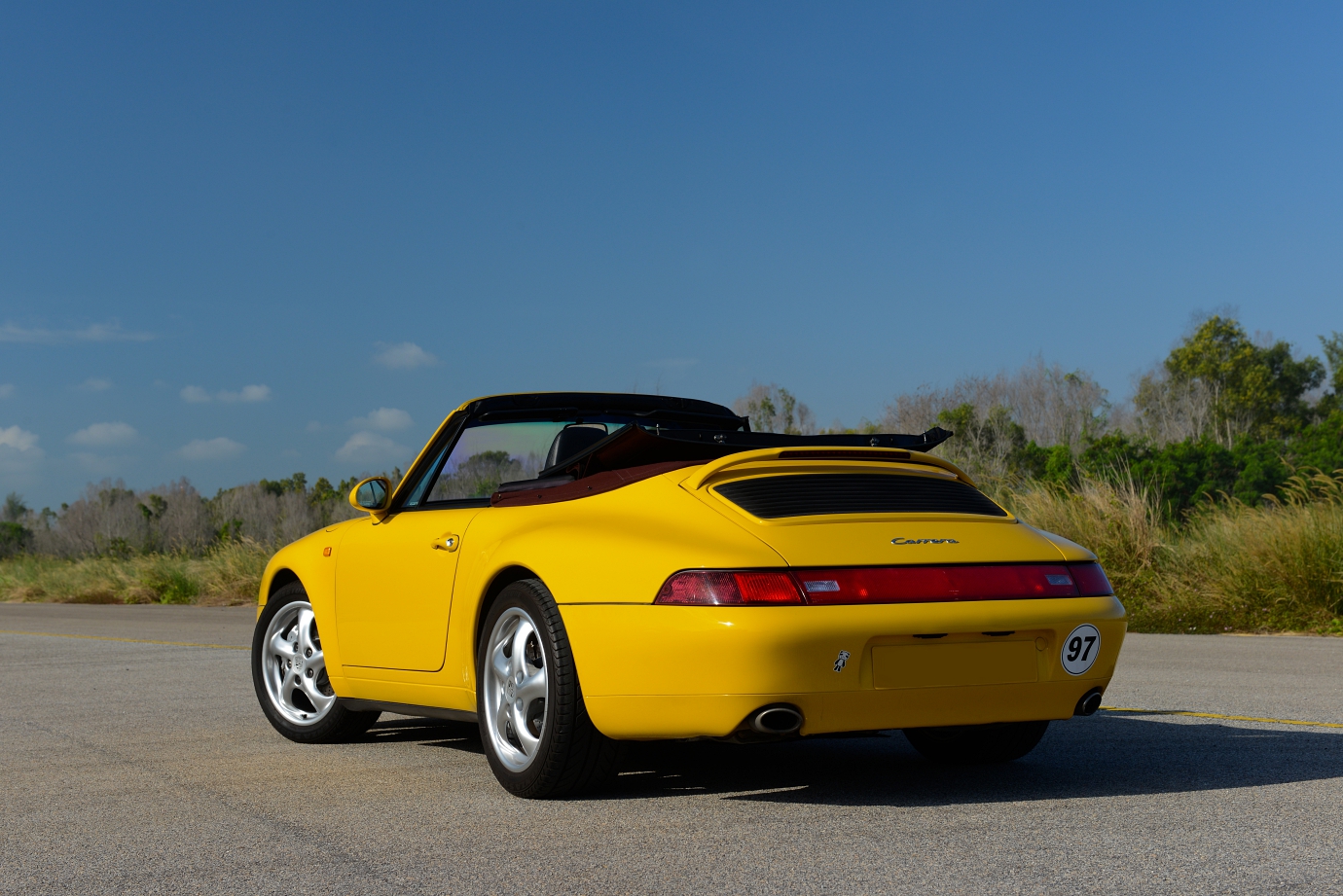
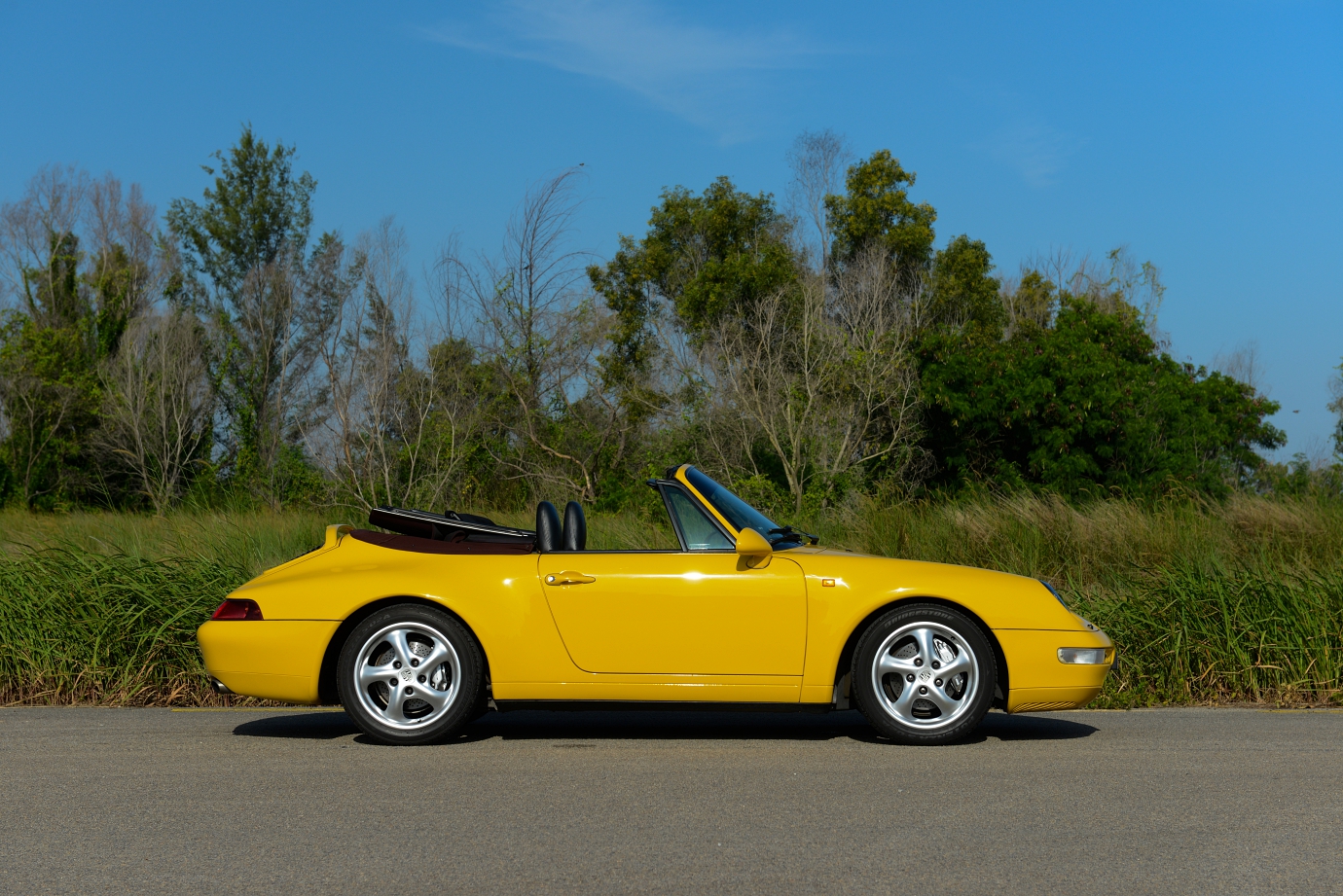
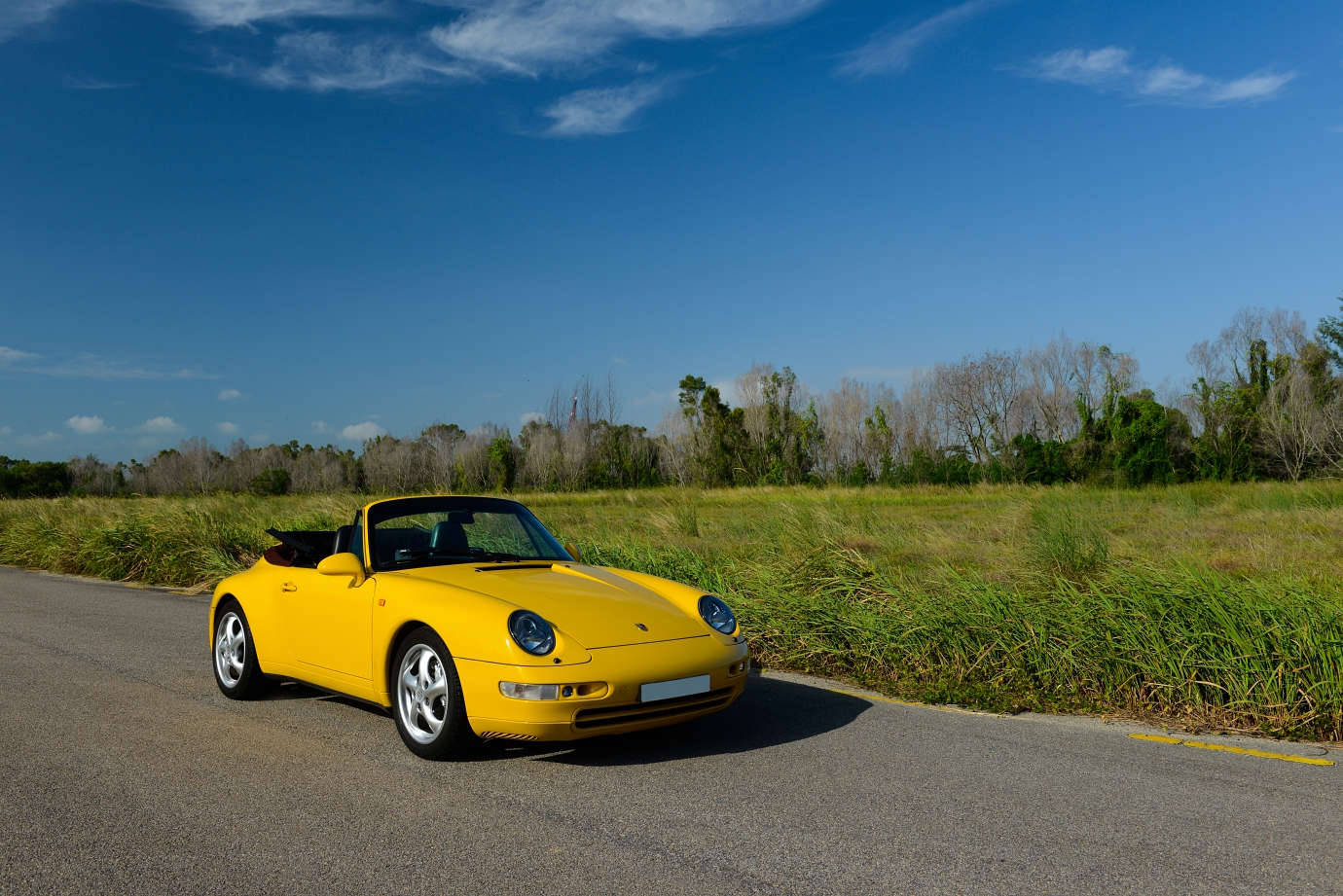
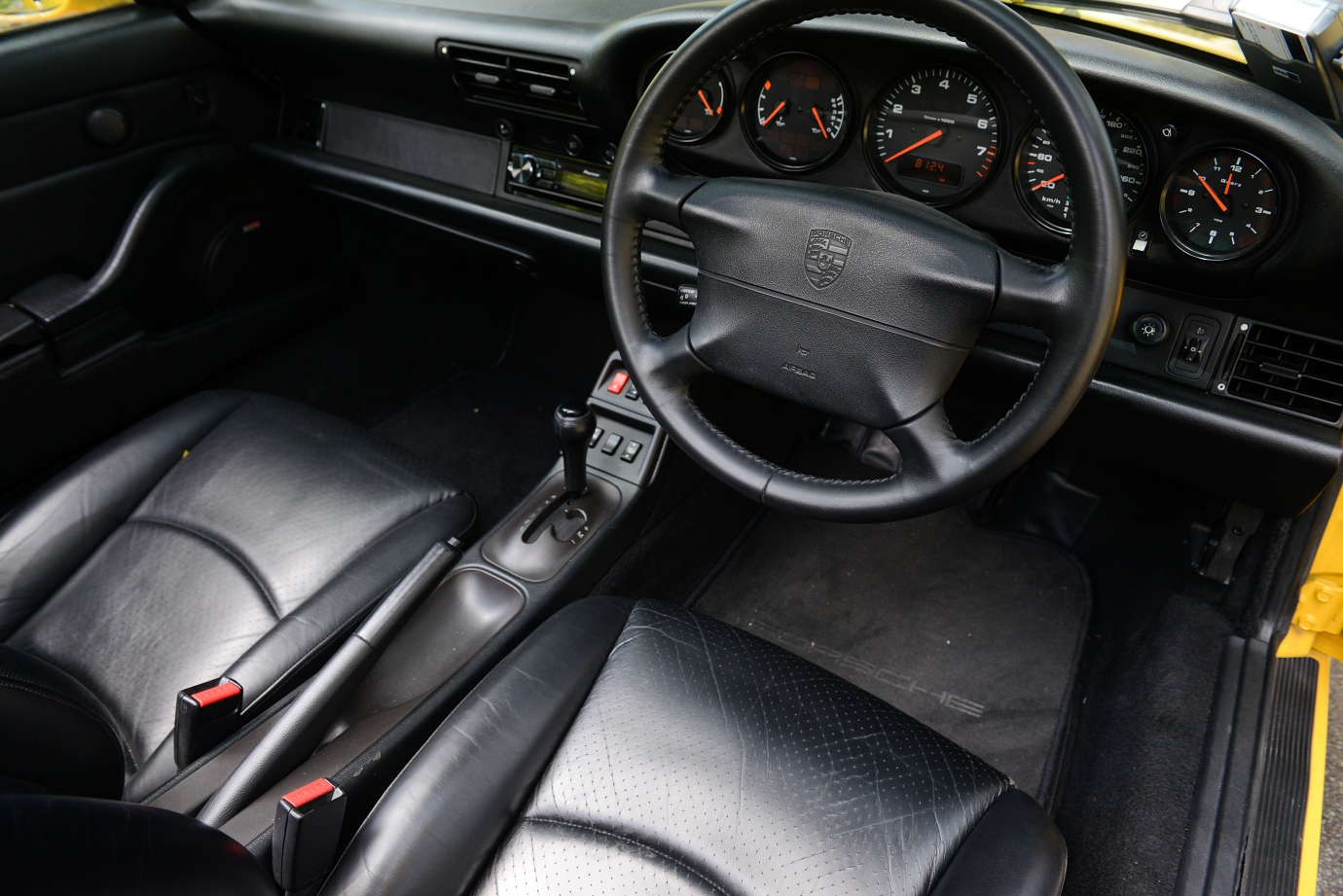
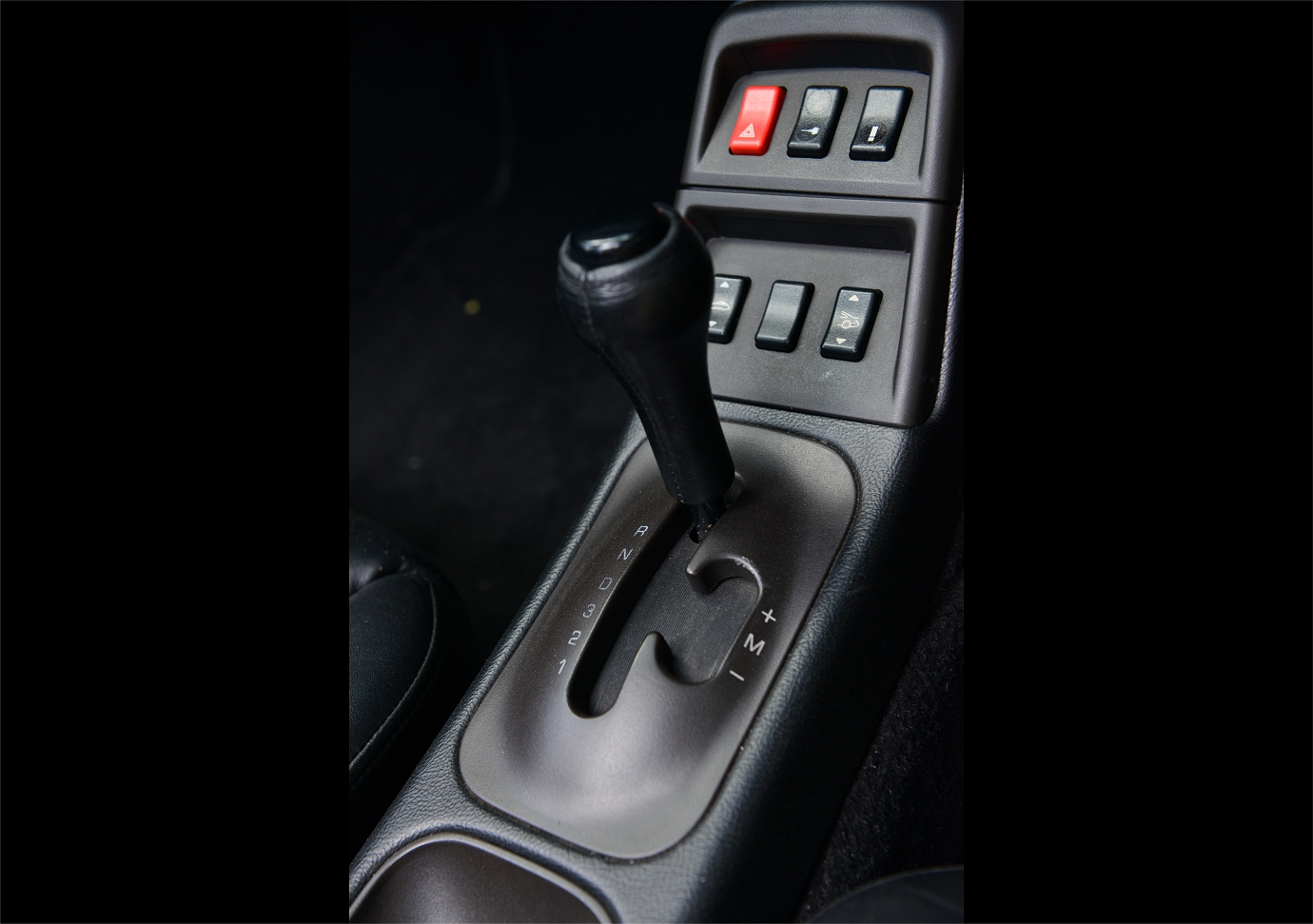
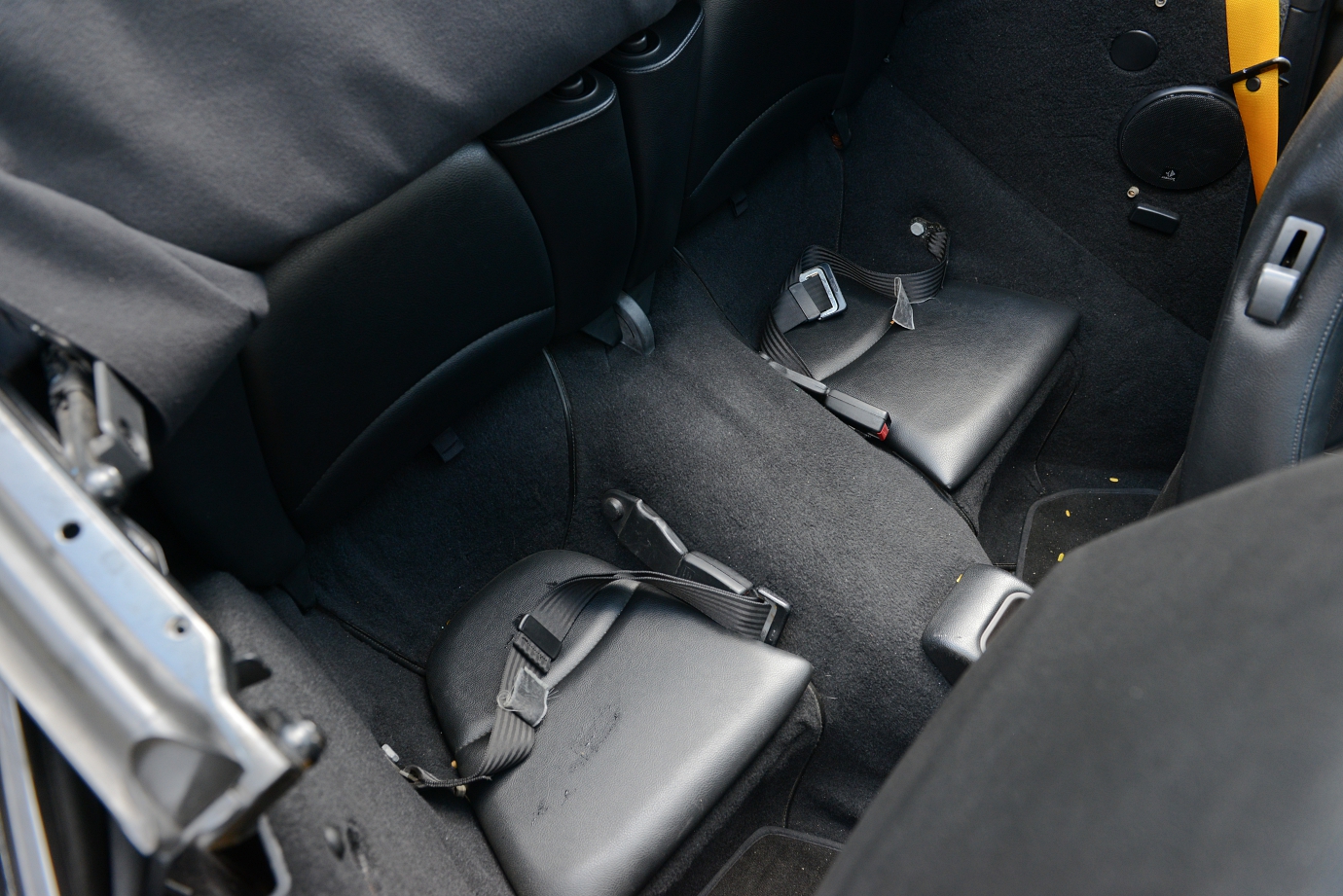
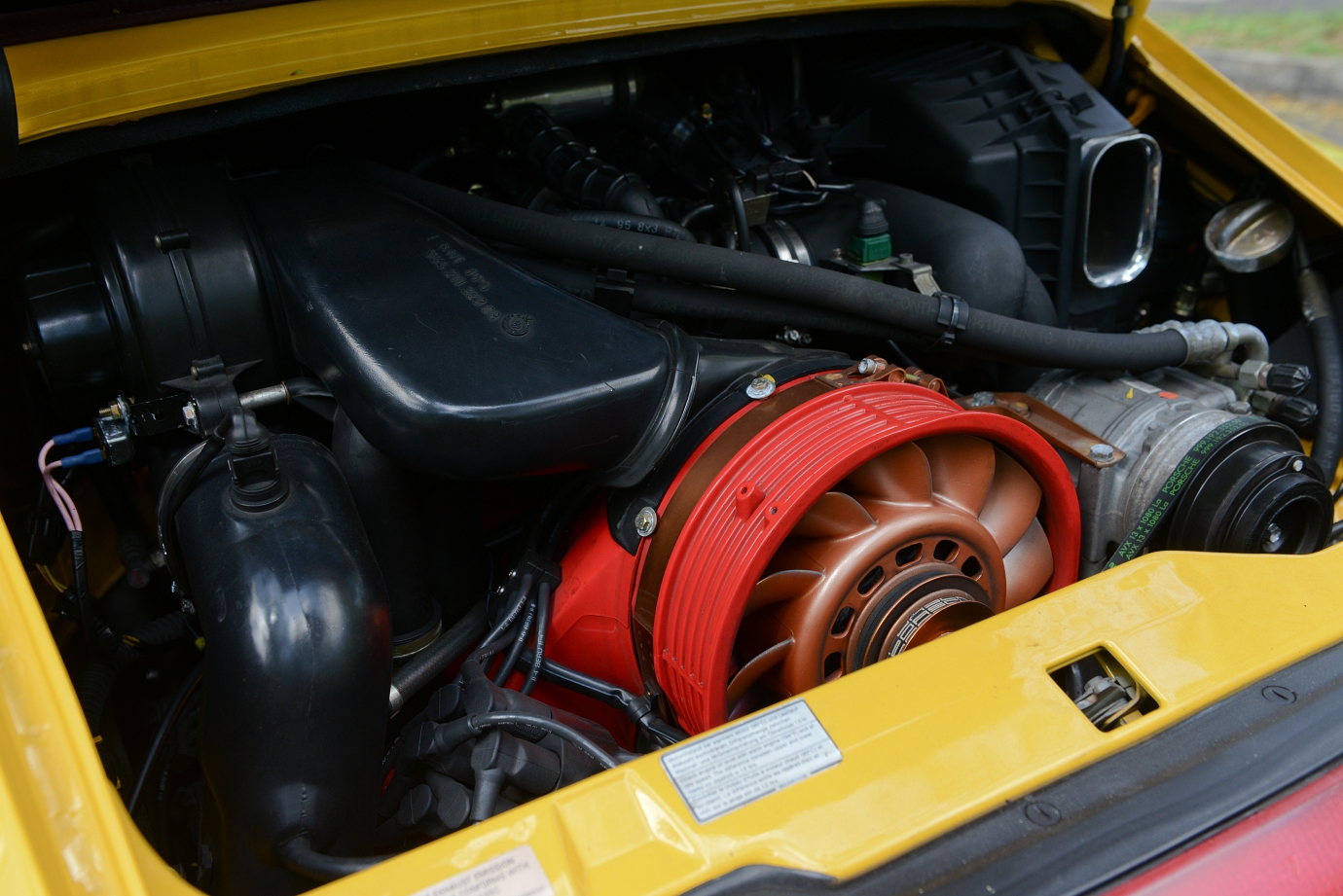
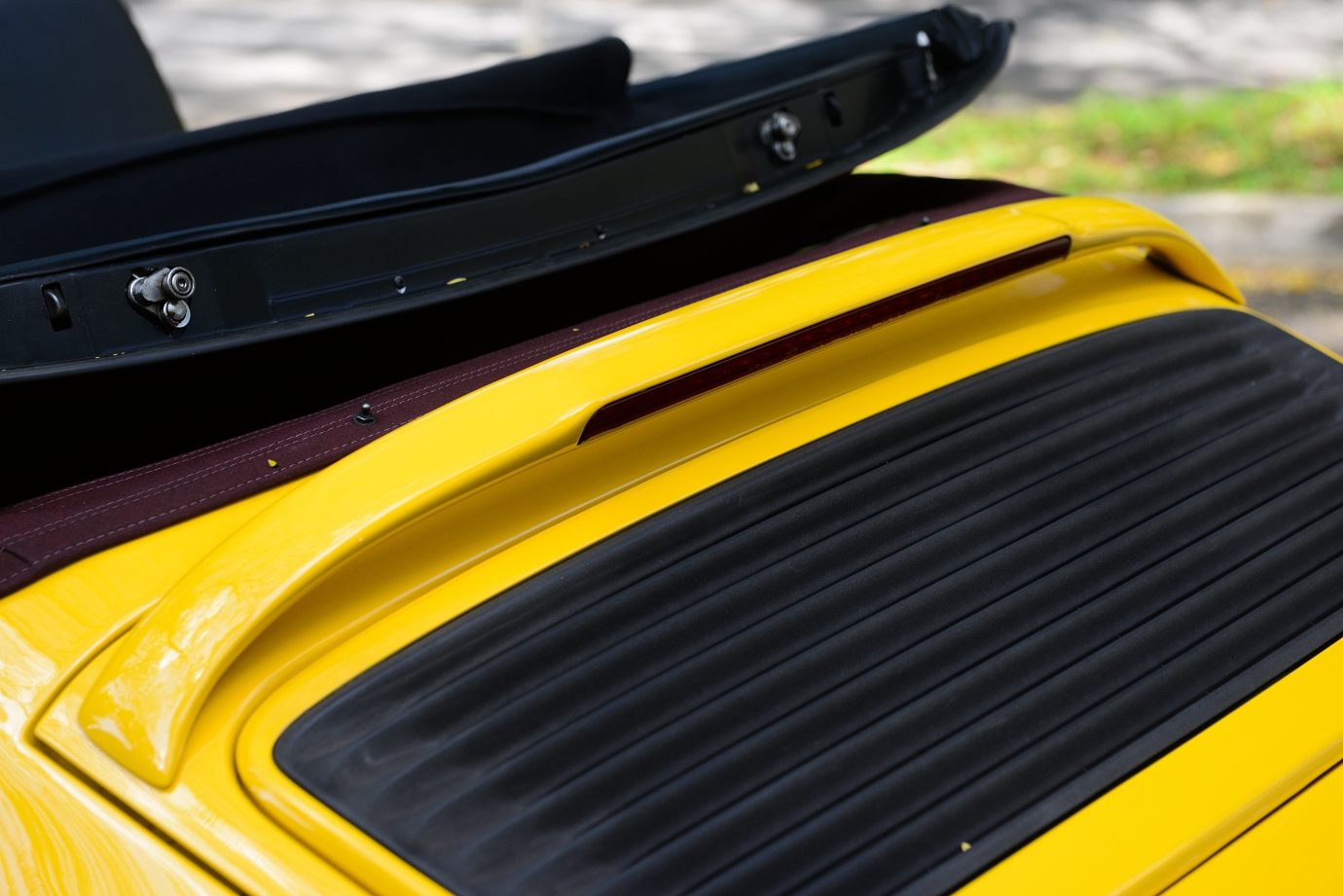
Dirty Fellow
The C2 ‘banana’ features a luscious aubergine roof that you won’t be able to appreciate in the photos, since well, we’re shooting everything top-down.
Its compact proportions cut an elegant silhouette, especially since its rump-end is unfettered by a fixed wing – that discreet ‘handlebar’ you see is for the third brake-light, which is mandatory in Singapore.
However, less charitable souls have suggested this is to give you better grip when you’re pushing it after it breaks down!
Banana gets the rising spoiler that is deployed at speed – however, if you’re feeling showy, you can always raise it via the button in the cabin.
Top-up or down, this gorgeous air-cooled has the most elegant profile of the trio, not least because the 930’s silhouette is dominated by a humongous whale-tail!
Its blend of modern aesthetics and retro proportions means it’s easy-on-the-eye without being too girlie or hairdresser, but it’s not till you see it alongside the 991 that you begin to appreciate how the 911 has evolved and grown through the years.
At the business end of things sits the air-cooled 3.6-litre M64 flat-six that was to be a swansong with the 993 – the subsequent type 996 would move towards water-cooled engines. What’s the allure of the air-cooled engines, you ask?
Such cars are about evocative emotional quotient, not necessarily about who boasts bigger numbers or who is faster – the cacophonous clatter, smell and magical sound of an air-cooled at full-pelt are things you need to savour ‘live’.
In this iteration, the engine produces 272bhp and 330Nm, which are channelled to the rear-wheels via a 4spd tiptronic transmission.
It’s more leisurely cruiser than bruiser, with a surefootedness that comes from the revised rear suspension (over its 964 predecessor), which just means you’ll have ample time to enjoy the wind-in-hair motoring.
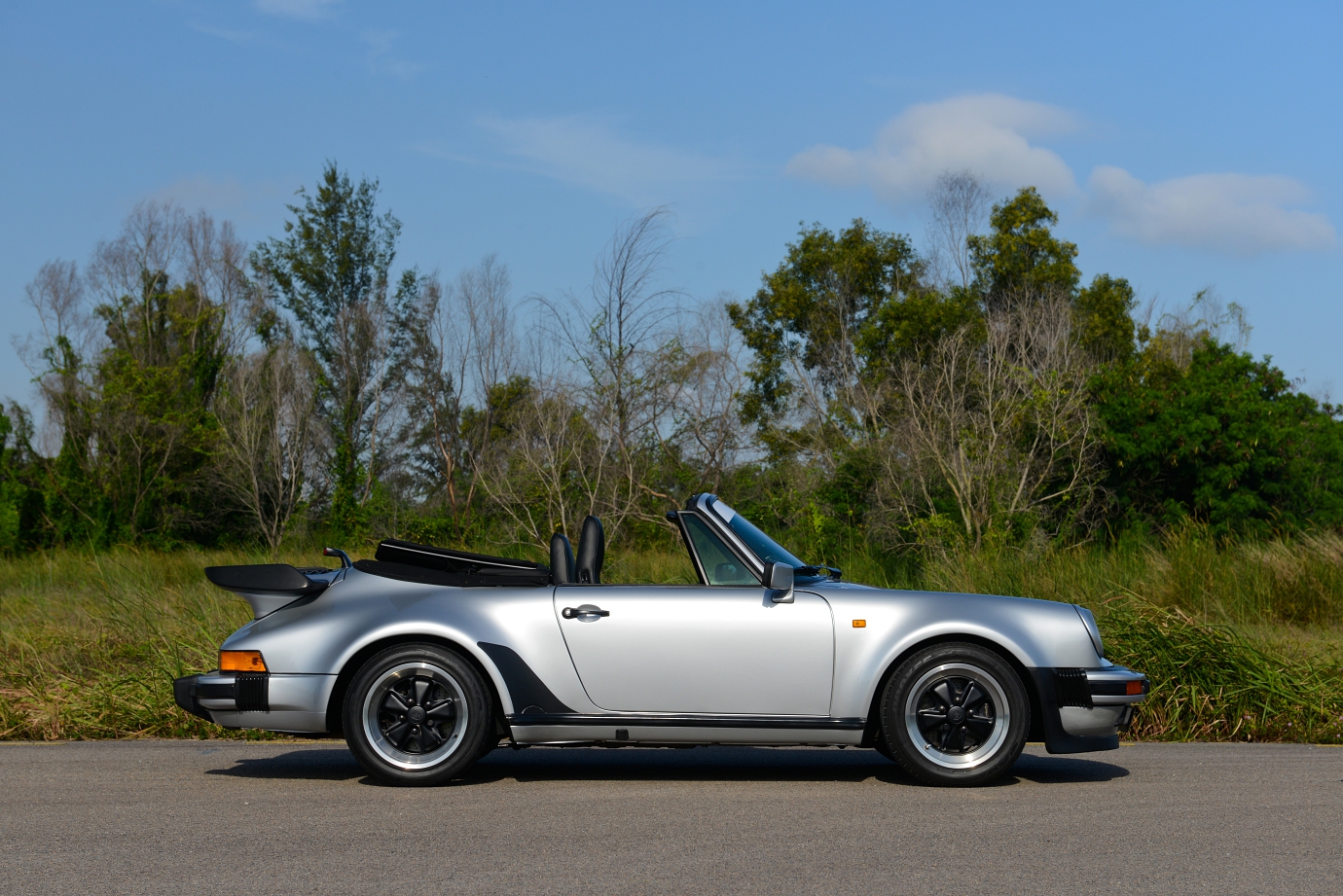
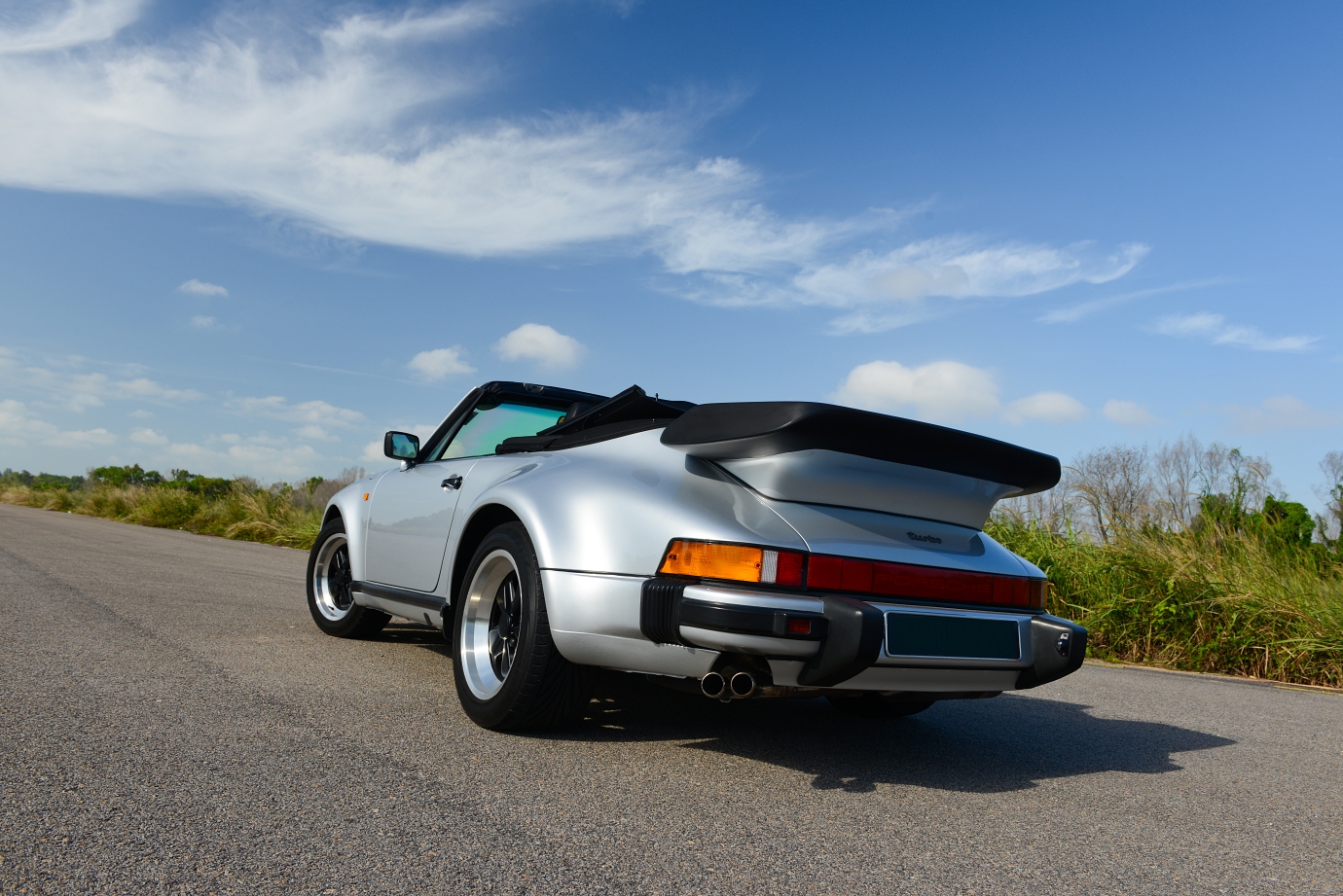
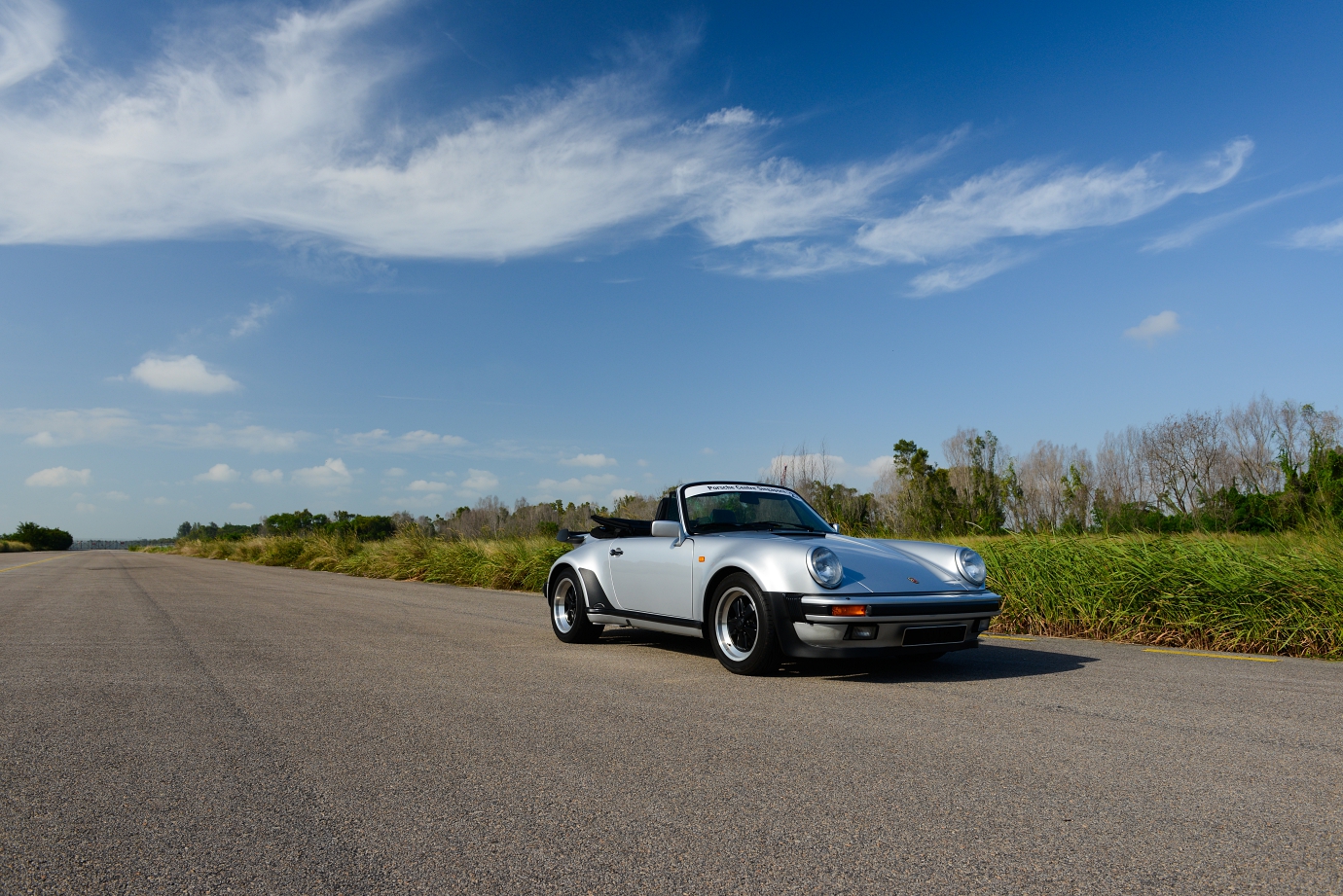
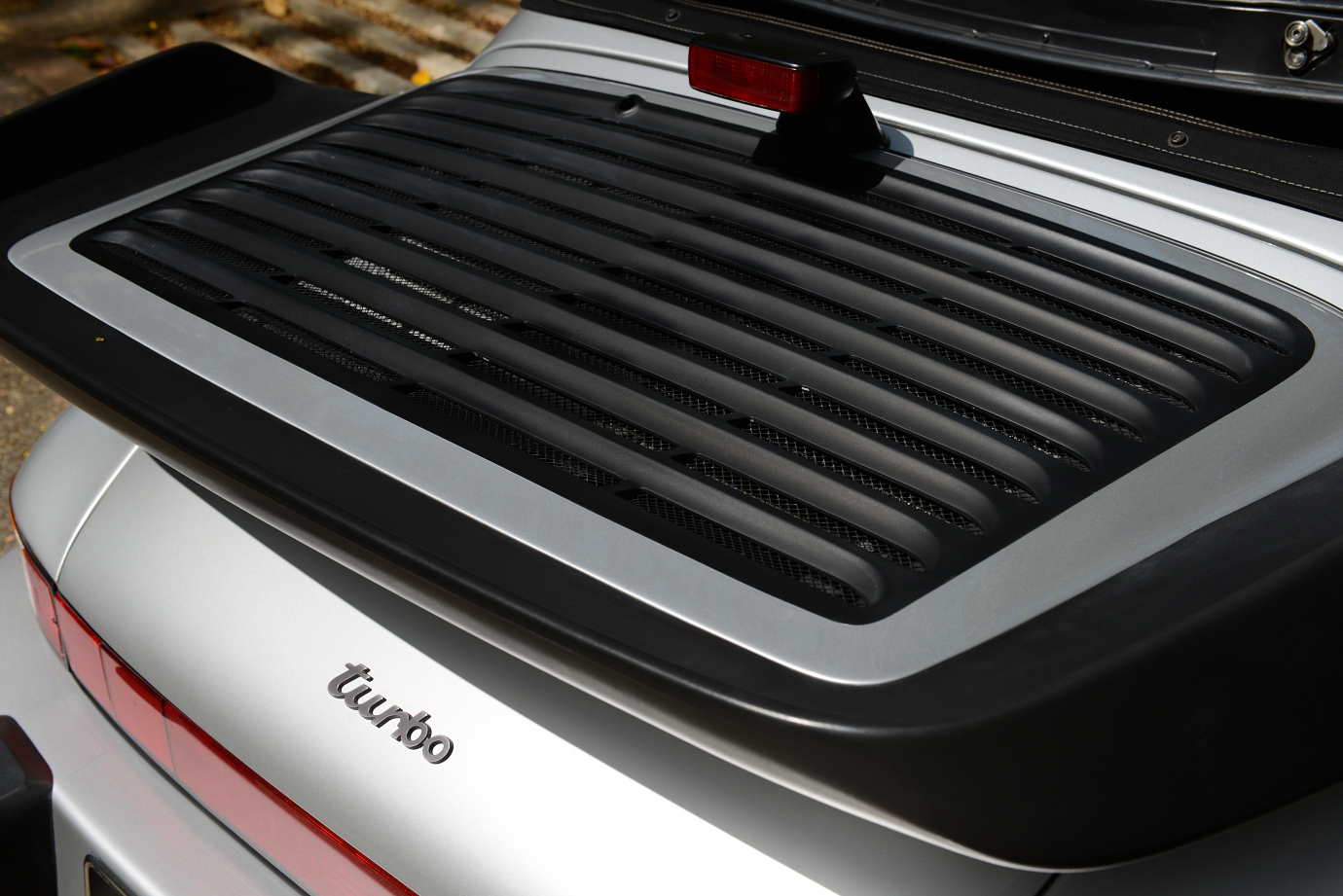
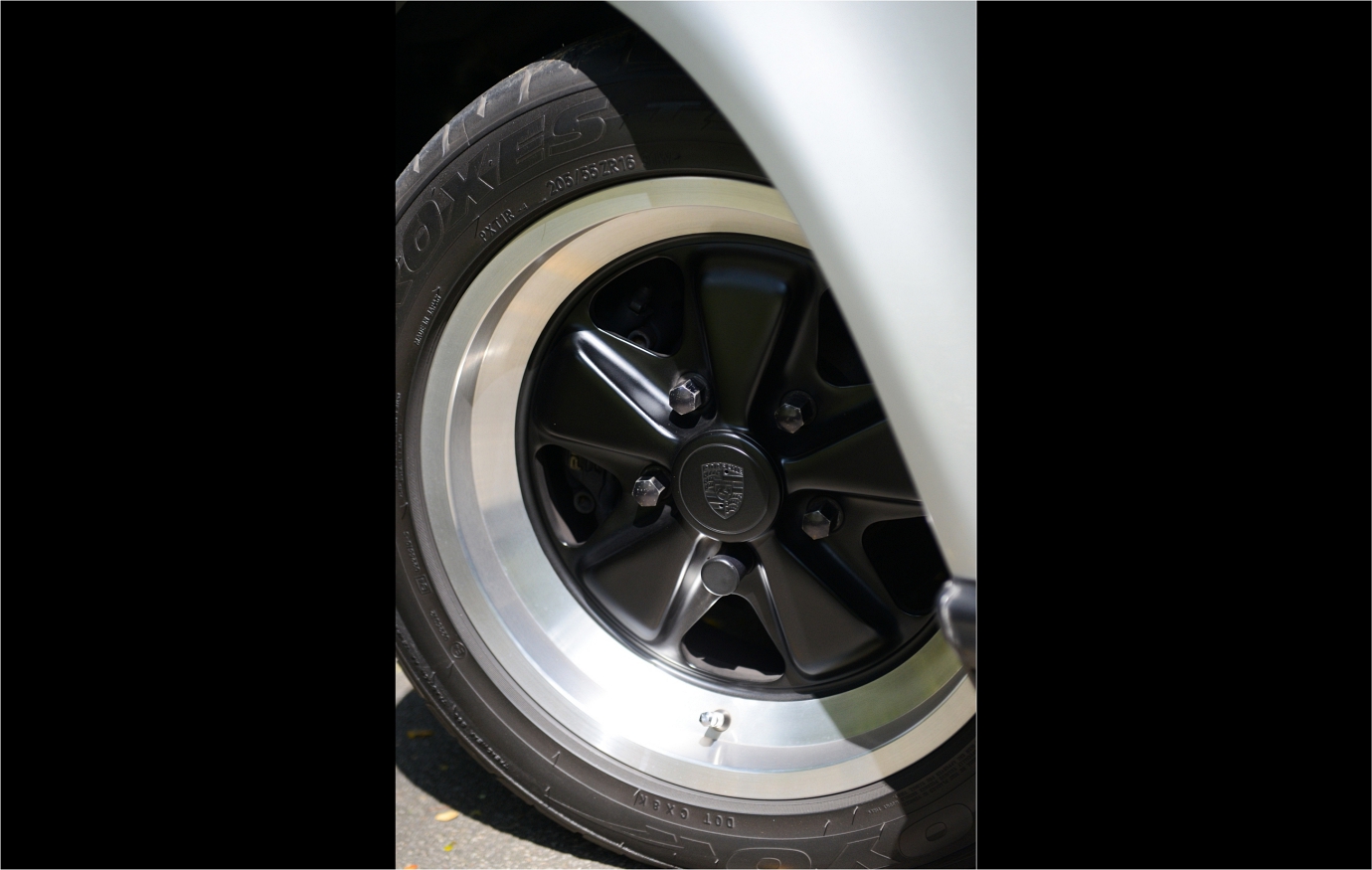
Silver Surfer
We hear the approach of the original ‘widowmaker’ well before we see it, since our ears are gently massaged by the 3.3-litre flat-six’s creamy, dulcet purr as it cruises towards us.
The vision of loveliness that is the 930 Cabriolet (911 Turbo Cabriolet) may be a product of the 1980s (1987 to be exact), but it looks as imposing today as it must have back then, especially with the distinctive ‘whale-tail’ so synonymous with the Turbo model.
Of course, the anoraks will notice that the spoilers on these later cars were further evolved so they more closely resembled ‘tea-trays’, but we think ‘whale-tail’ sounds far cooler!
Built on the G-series 911 platform initially for racing homologation but subsequently series production, the ‘930’ Turbo was the first road-going turbocharged 911 for the brand, who decided in the 1970s that it could offer its enthusiast owners the performance they were familiar with by recourse to turbocharging, specifically to the tune of 260bhp and 343Nm.
Back then and up to the type 964, the Turbo was only available in a real-driver’s favoured configuration: rear-wheel drive and stick-shift only.
Unfortunately, the rear-engine layout, monumental turbo-lag and short wheelbase meant on-limit handling was tricky, even with the wider tyres for additional grip, which led to the unfortunate moniker of ‘Widowmaker’.
This nickname has since gravitated to the GT2, as the Turbo and Turbo S flagship models gradually evolved to become all-wheel driven.
Much like today’s Turbo and Turbo S models, the original 930 wasn’t created solely to please the performance die-hards, but became the flagship of the brand with all manner of premium amenities included.
As we know, not all owners are created equal and range-topping models like the Turbo invariably attracted folks who often had more money than driving ability, which led to unfortunate incidents as they tried to tame their beasts.
Of course, the brand’s expertise in motorsports did filter down to the 930 right from the outset of the first generation’s 3.0-litre, such as sophisticated turbocharger technology (to address the relative lack of poke in low rpms), a stronger gearbox and more advanced brakes (ventilated discs and aluminium callipers).
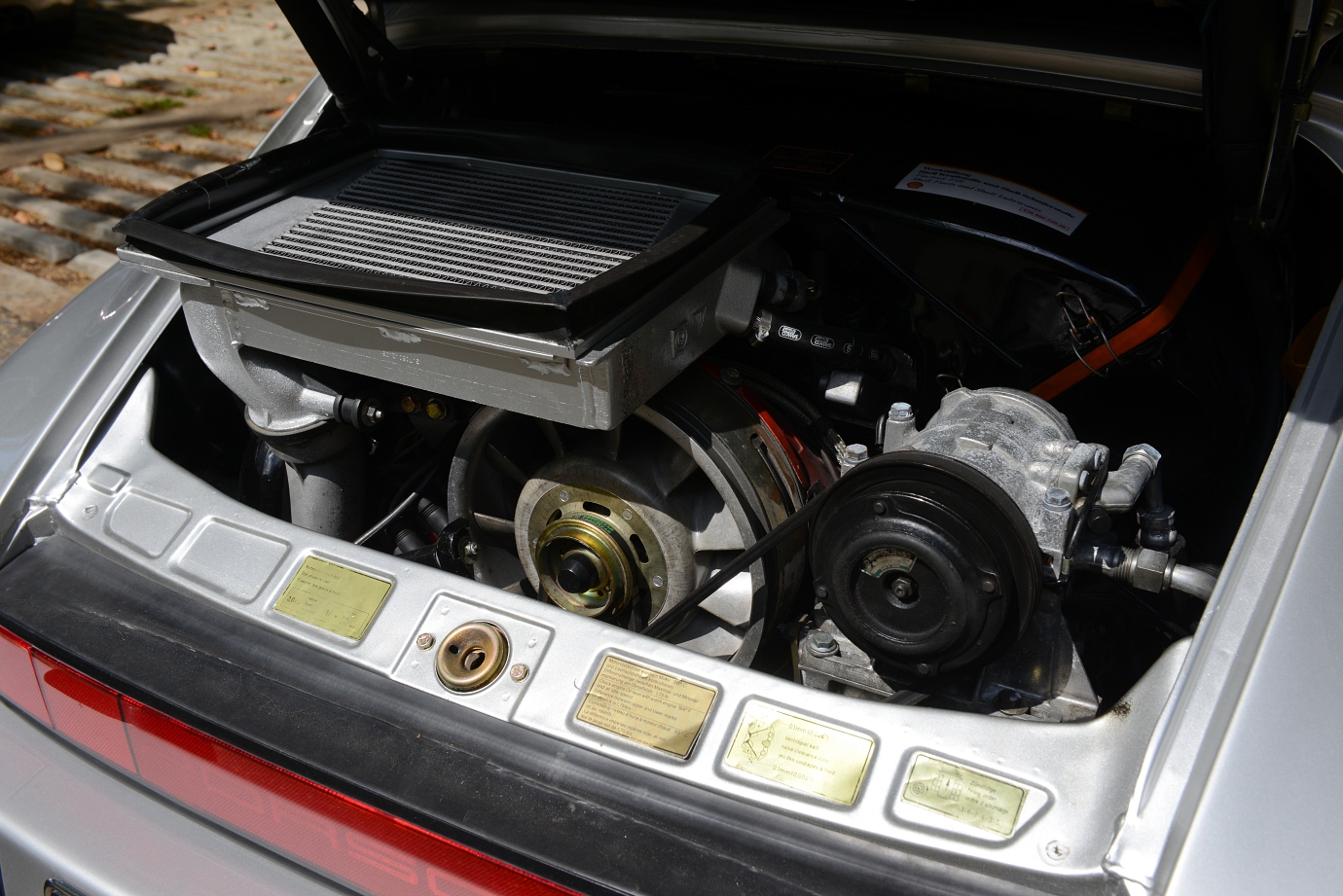
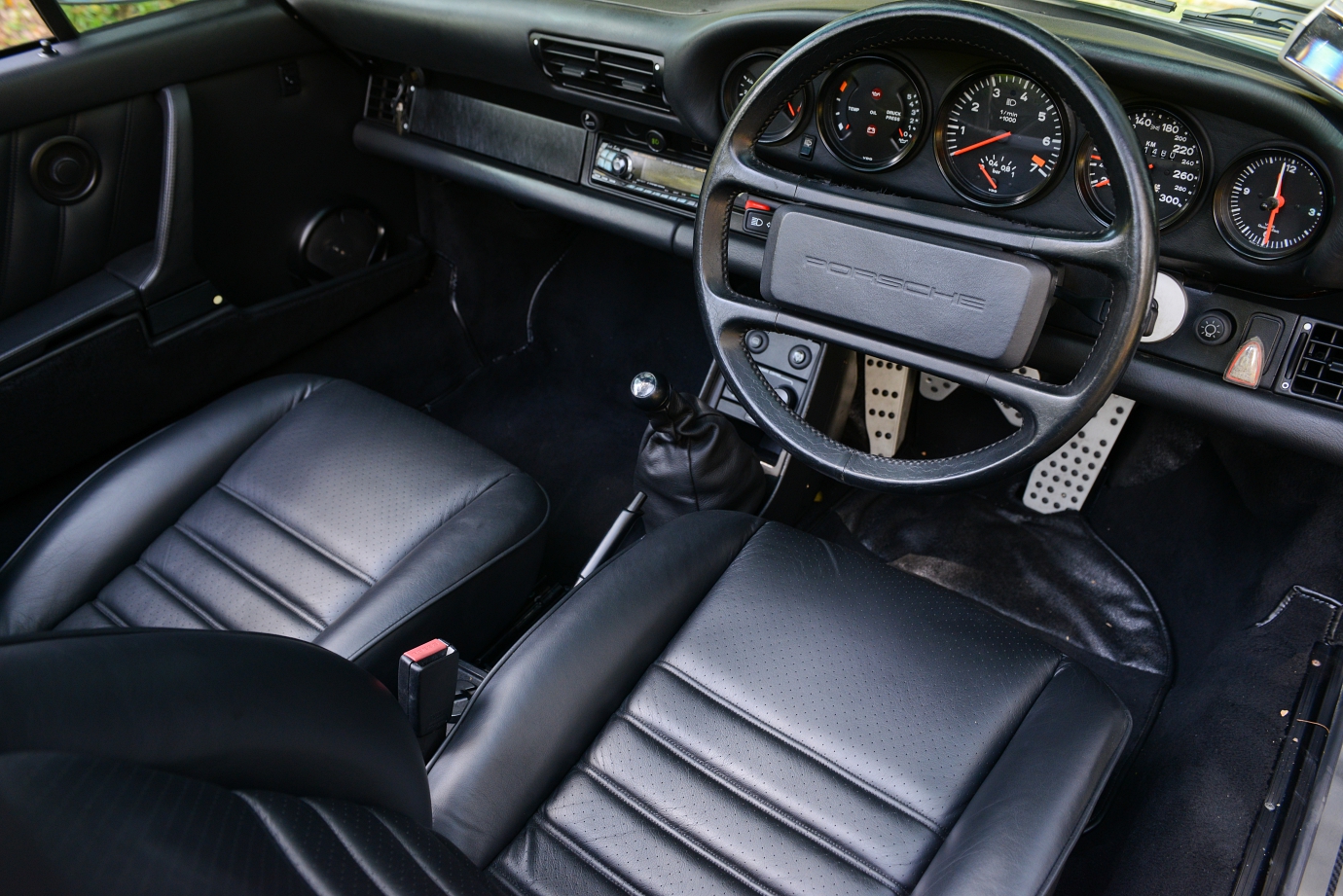
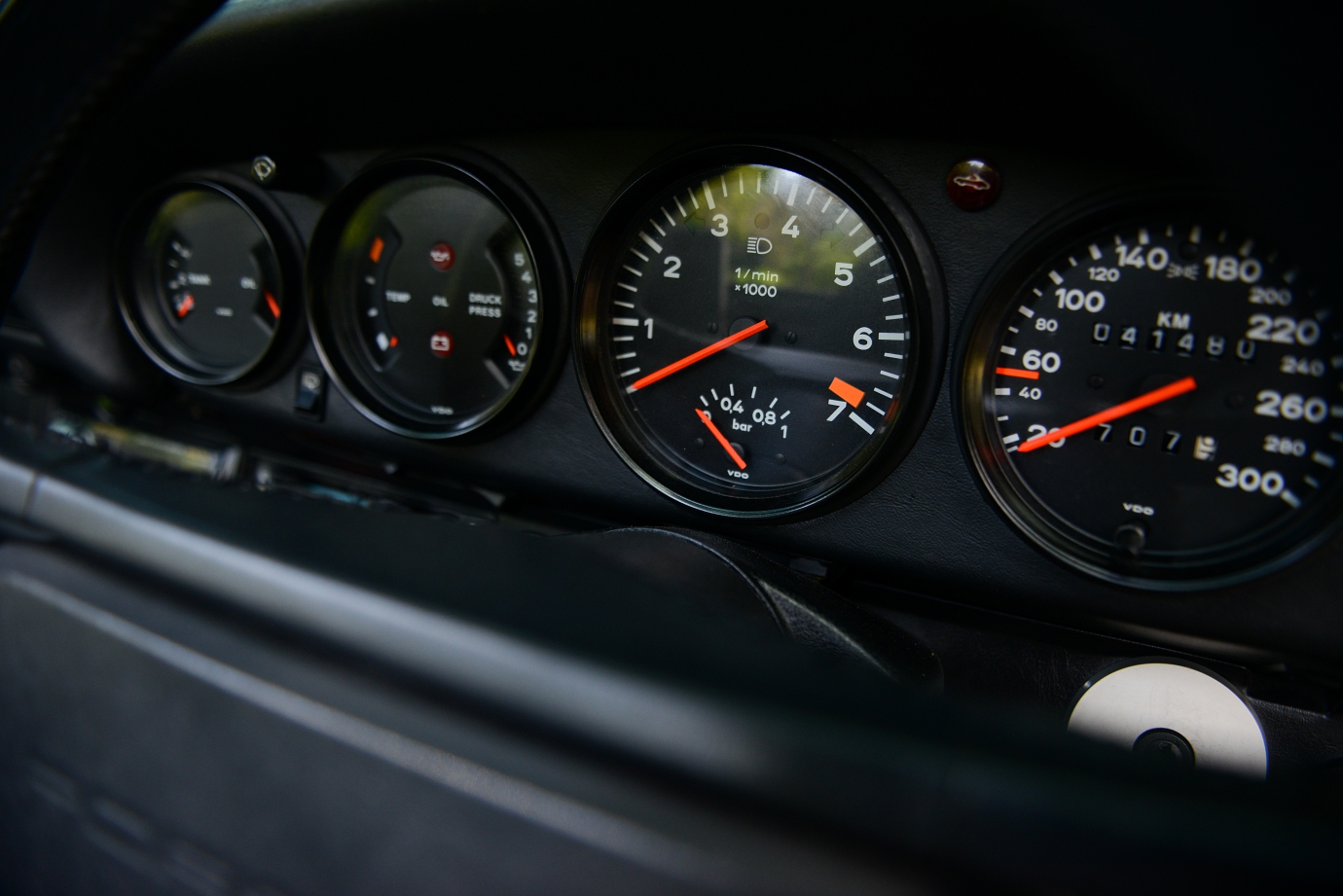
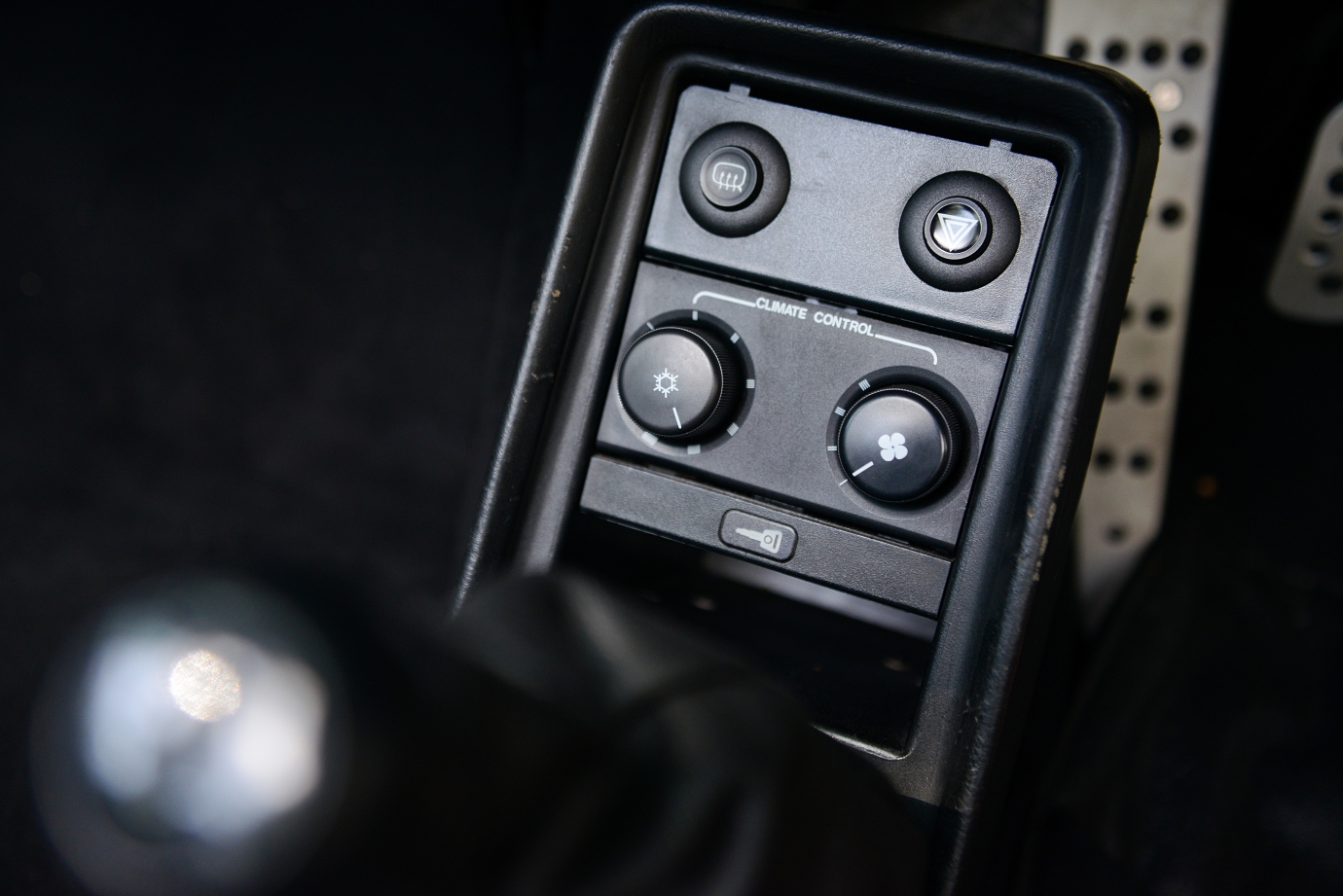
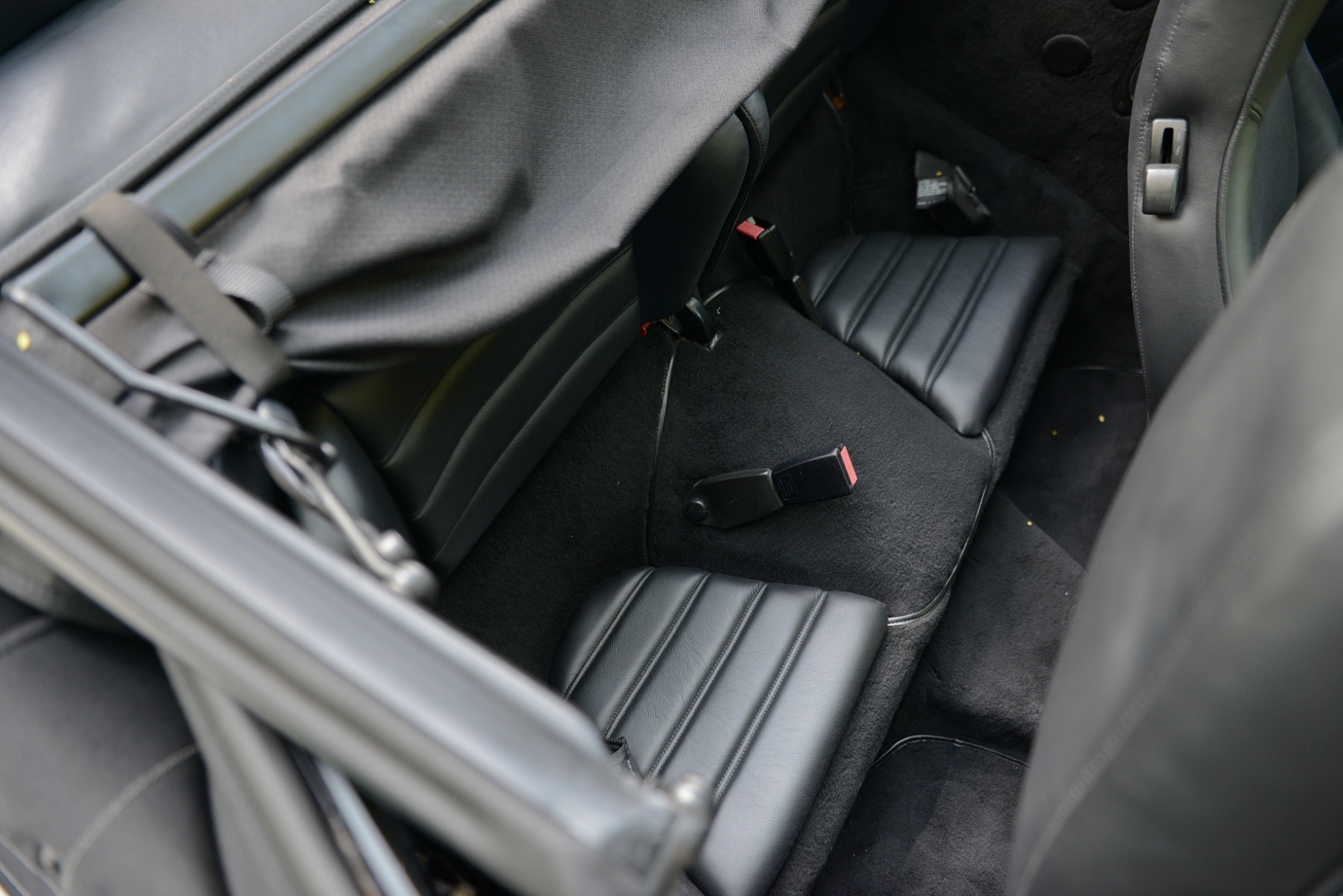
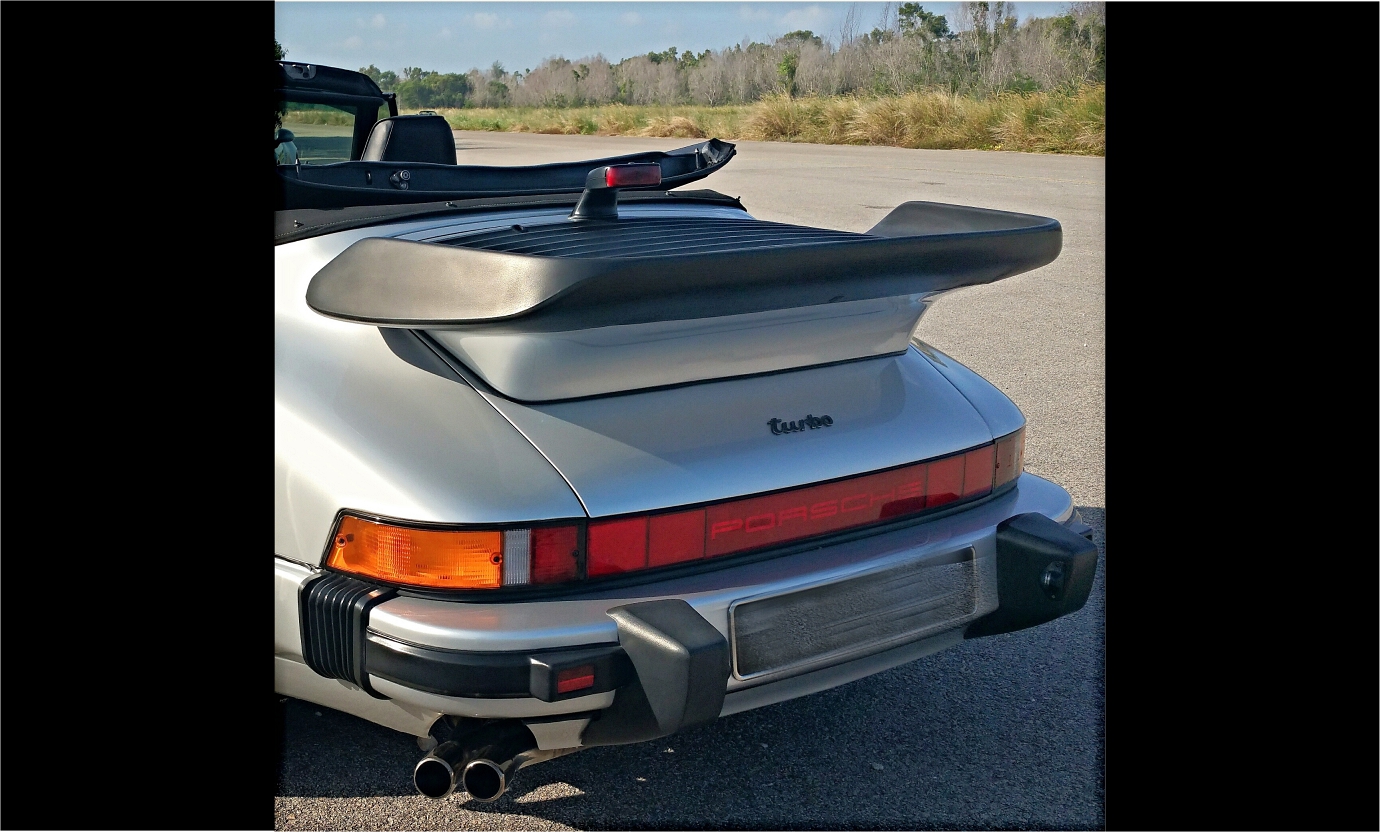
The intercooled 3.3-litre that animates this silver surfer is a further evolution of the engine that sees its performance increase to 300bhp and 433Nm. It may seem modest by today’s standards, but don’t forget that in those days, driving was a mechanically visceral white-knuckle experience bereft of the knuckle-cracking nanny aids of today.
Getting it wrong along a winding country road then could mean wrapping man and machine around a big oak tree. This was a performance juggernaut of the era of hairy-chested proportions that saw a 250km/h top speed and the 100km/h sprint dispatched in under 5 seconds, all through a 4spd manual gearbox.
As you can imagine, the 930 Coupe is already something of a cult collectible with only a handful of examples in Singapore of varying provenance, but when you start talking Cabriolets, there’s just this solo, beautifully restored car here. Like many old-school sportscars, extracting its performance requires commitment and dedication.
(Click HERE to read about the other 911s that require commitment and dedication – the RS models)
There’s none of today’s ‘accessible performance’ hogwash with the 930, where anyone can tap into the full fury of the engine. If anything, pottering around below four-and-a-half thousand rpm would make you wonder if the turbo is broken, since the magic only starts towards the five-thou and up rev range.
Once the fireworks begin, the soft purr of the flat-six takes on a harder edge as its augmented by all the characteristic turbo noises we know and love: fizz and whizzes, gasping whooshes and ‘snaps, crackles and pops’ for punctuation help transform the docile soundtrack into a raging mechanical symphony.
The cabriolet transforms into a veritable sled-hammer, as the gentle breeze-in-hair tickle rises in hurricane-anger and tosses what little hair we have around in a huge vortex of performance.
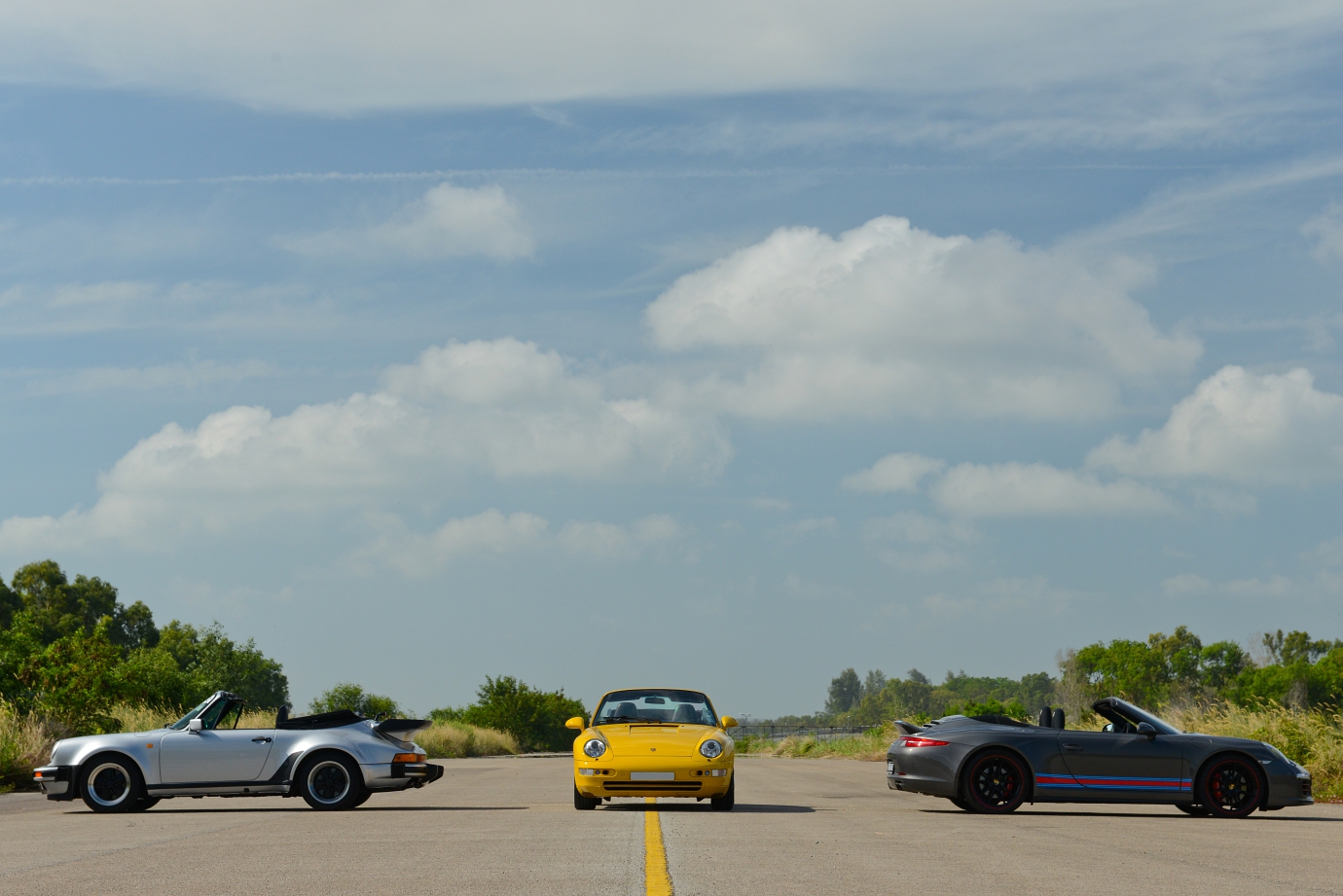
Tops Off Everybody
A much as we’re enthralled by sportscars, we’re intrigued by the flash of flesh when a cabrio is driven by with the top-off, even more so when we’re the ones driving it! The 991 C4S demonstrates how far the 911 has come, especially since the level of performance that was once considered ‘hardcore’ in the 930 Cabriolet is now relatively easily tamed through electronic trickery.
Despite the ease of access to such performance in the 991, we know there remains a good number of enthusiasts who prefer the mechanical manner in which the 930 delivers its old-school thrills (and hopefully not spills!).
On the other hand, the air-cooled 911 Carrera straddles the worlds of old and new with its genteel and elegant package, as its C2 guise lets us enjoy a leisurely, yet nimble drive down memory lane.
Couple all this to the fact that all 911 Cabrios will also sit two in the rear in a pinch and you begin to appreciate the model’s broad spectrum of sun-seeking personalities thanks to the different performance levels.
Well, what can we say? We were willing prisoners of the sun...
PHOTOS Vanq
Porsche 911 Carrera 2 Cabriolet
Engine: 3600cc, flat6
Power/rpm: 268bhp/6100rpm
Torque/rpm: 330Nm/5000rpm
Transmission: 4spd Tiptronic auto
0-100km/h: est. 6.7secs
Top speed: est. >250km/h
Kerbweight: est. 1450kg
Porsche 911 Turbo Cabriolet (type 930)
Engine: 3299cc, flat6, turbocharged
Power/rpm: 300bhp/5500rpm
Torque/rpm: 433Nm/4000rpm
Transmission: 4spd Manual
0-100km/h: est. 5secs
Top speed: est. 250km/h
Kerbweight: est. 1300kg
Porsche 911 Carrera 4 S Cabriolet (type 991.1)
Engine: 3800cc, flat6
Power/rpm: 400bhp/7400rpm
Torque/rpm: 440Nm/5600rpm
Transmission: 7spd PDK dual-clutch auto
0-100km/h: 4.5secs (4.3secs Launch Control)
Top speed: 294km/h
Kerbweight: 1555kg






